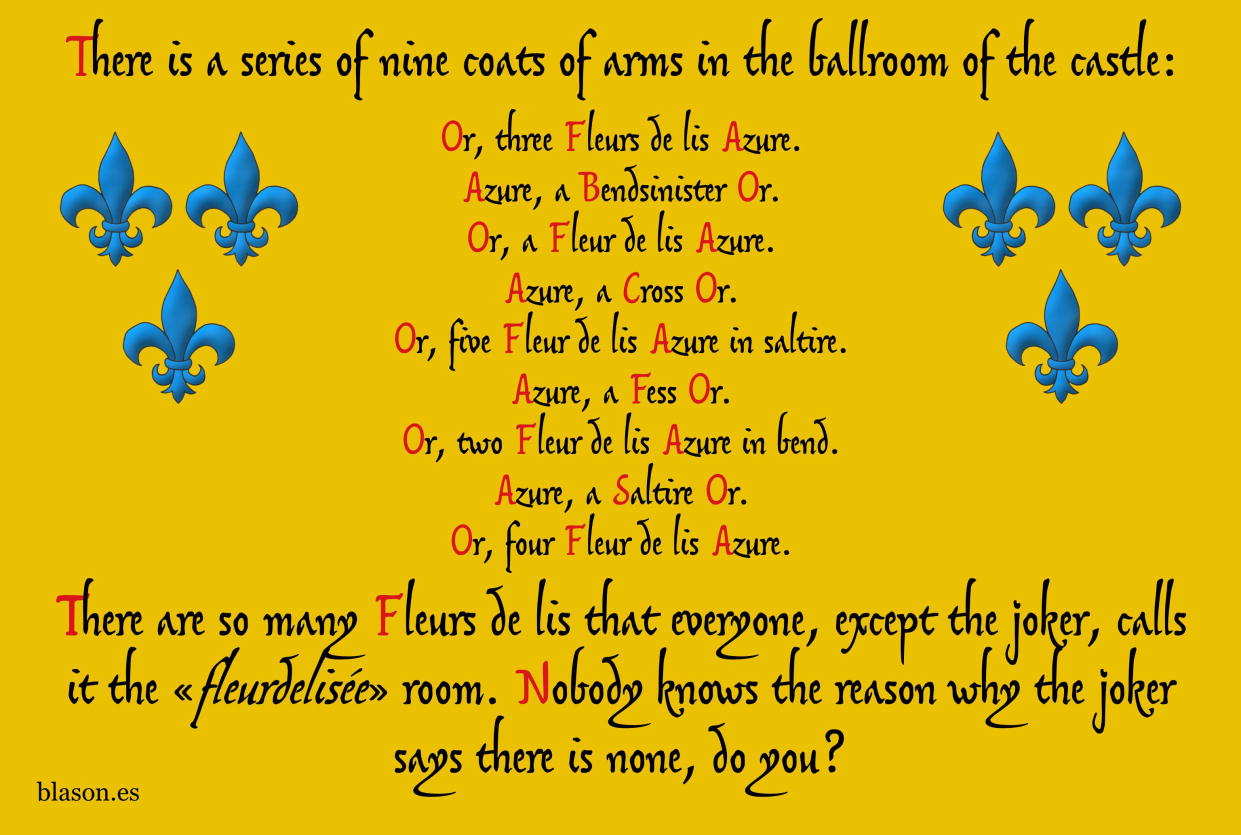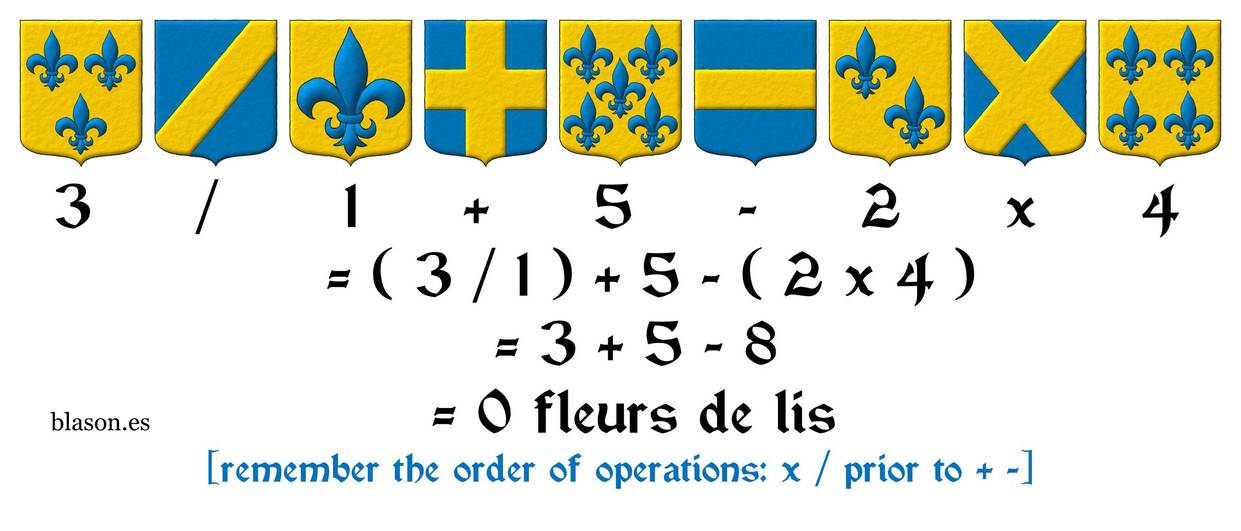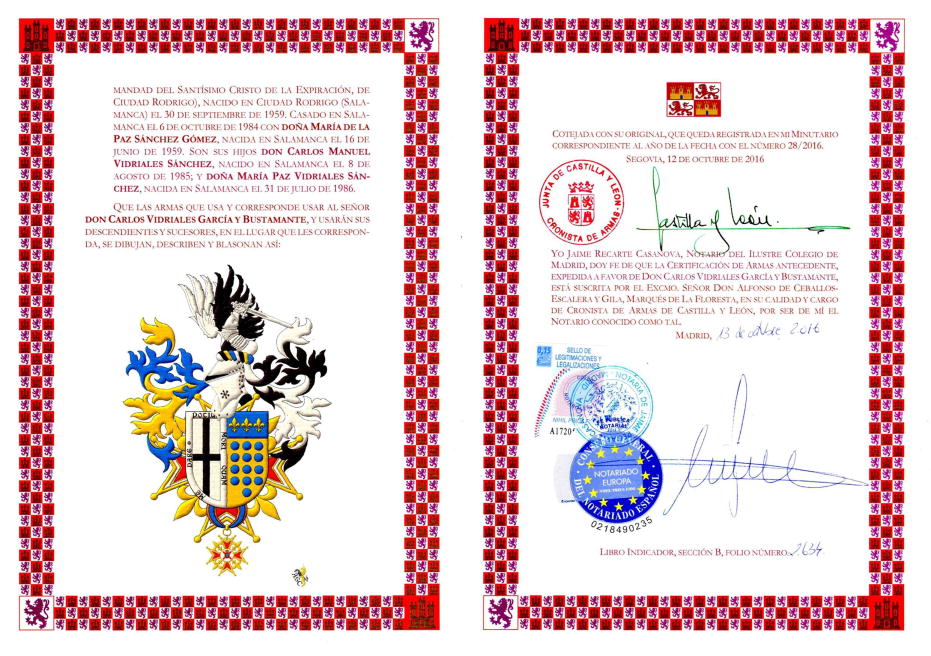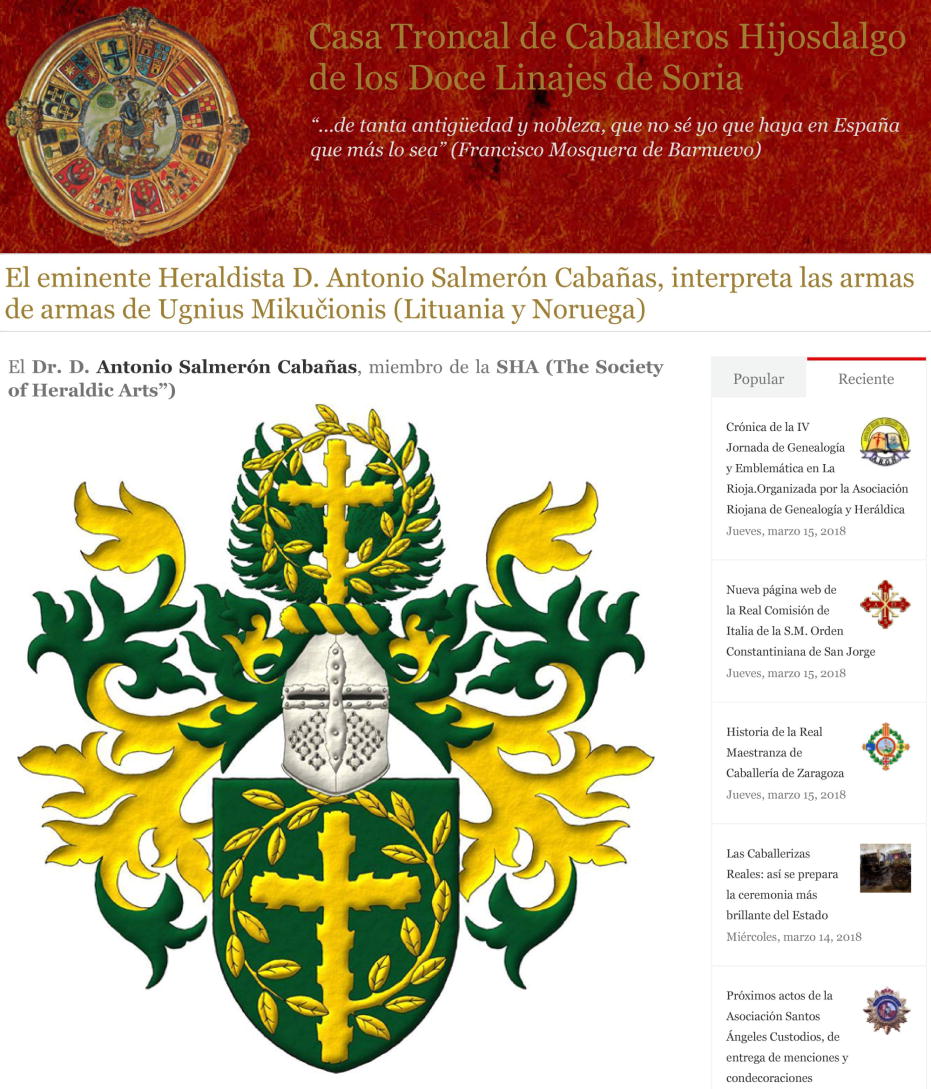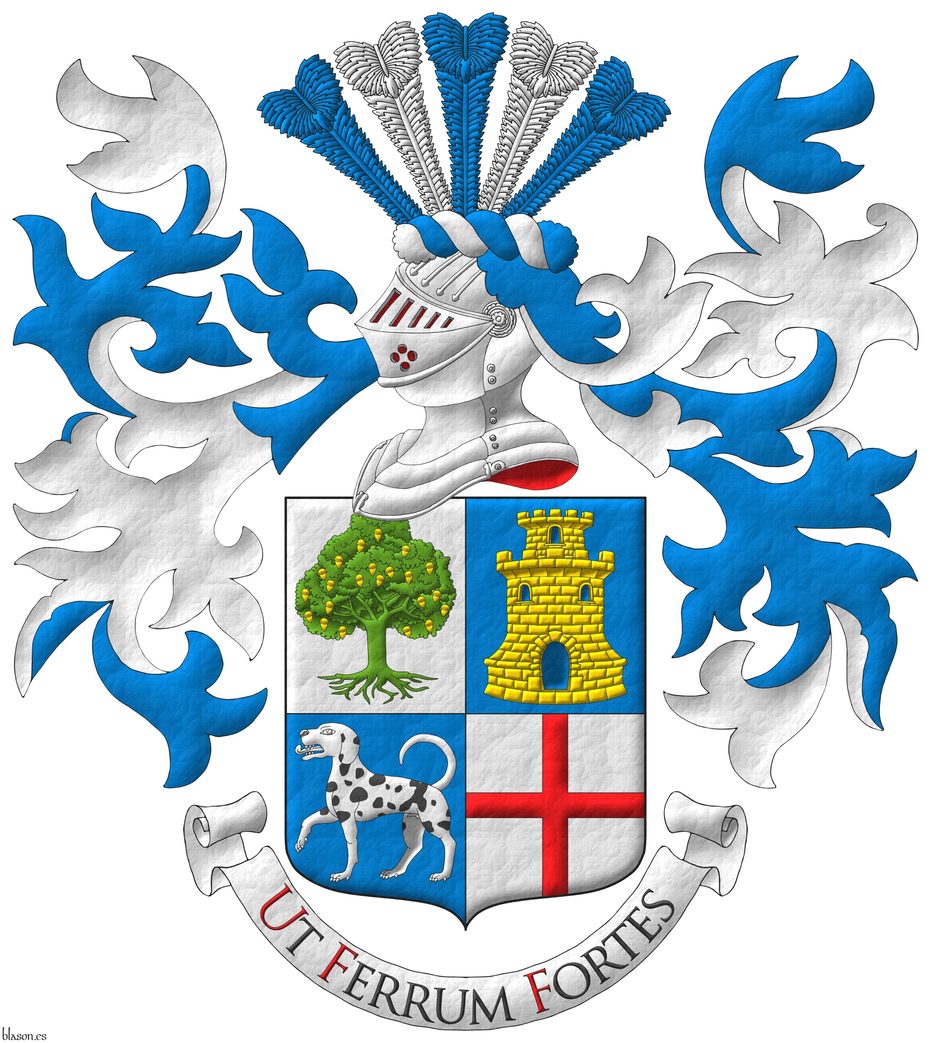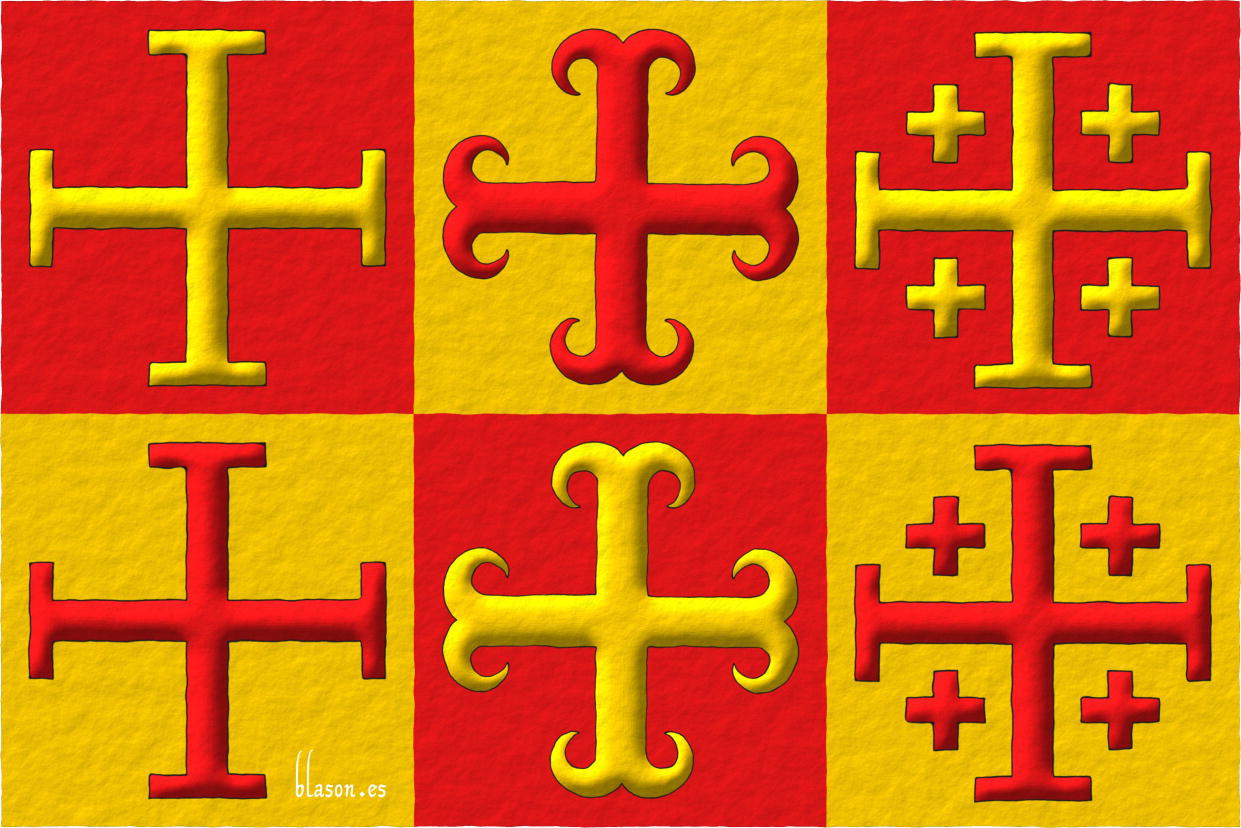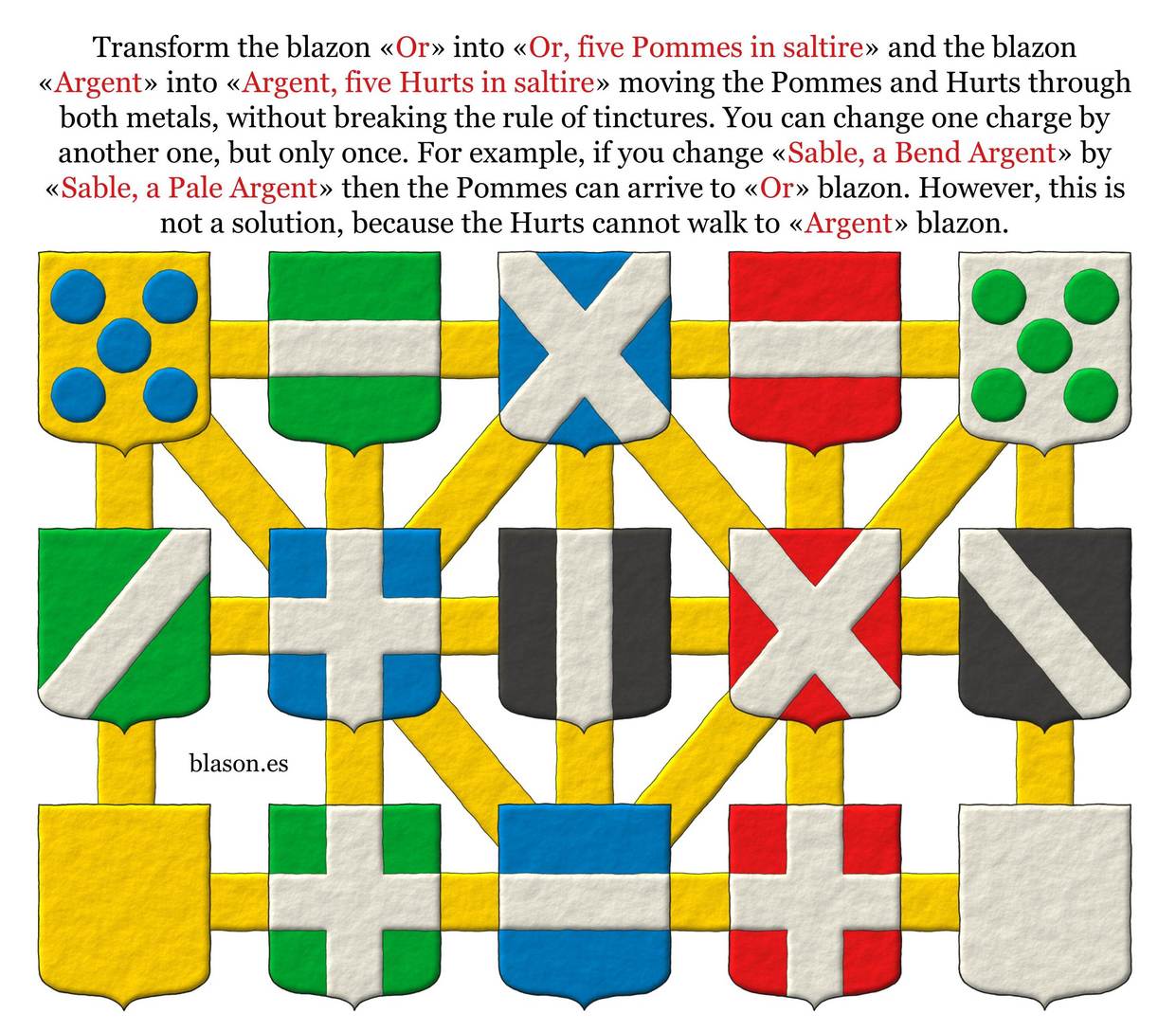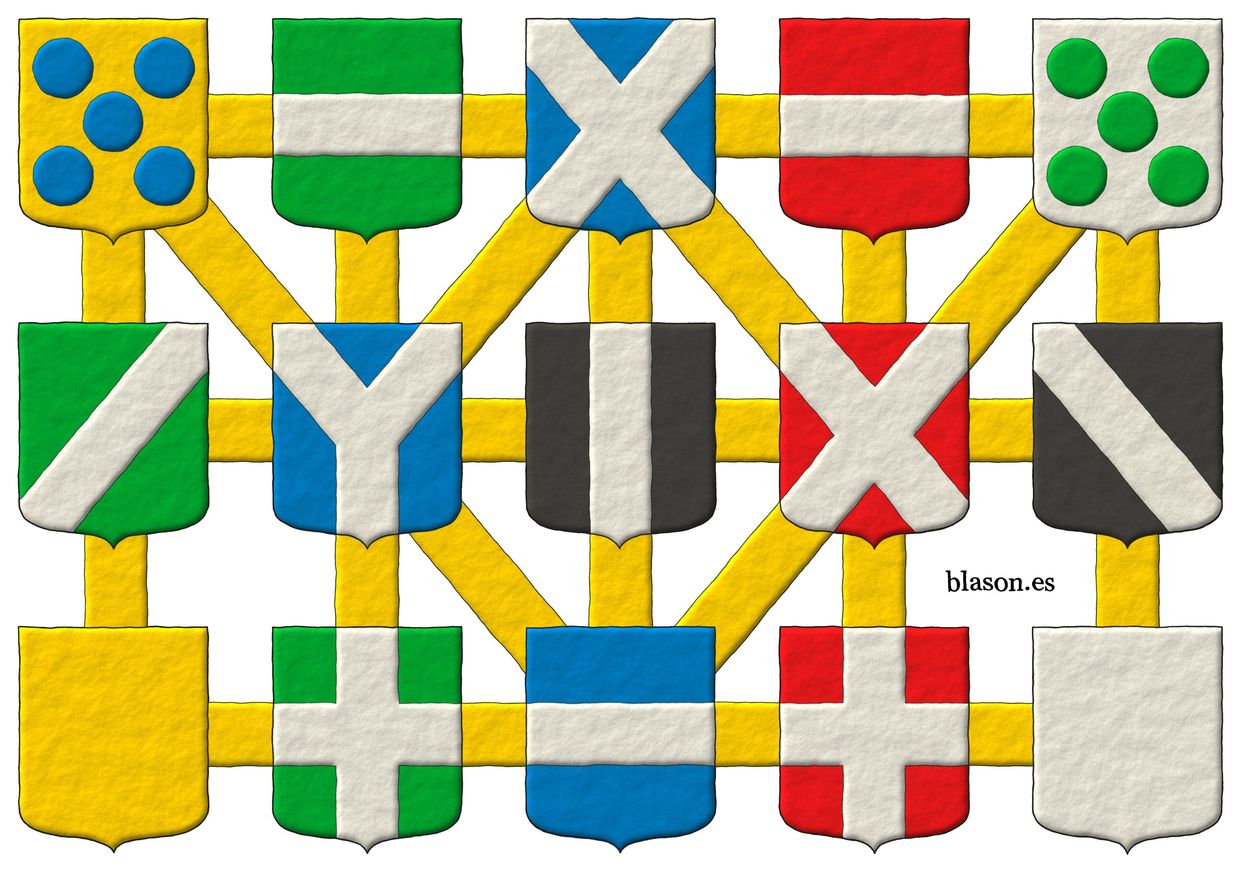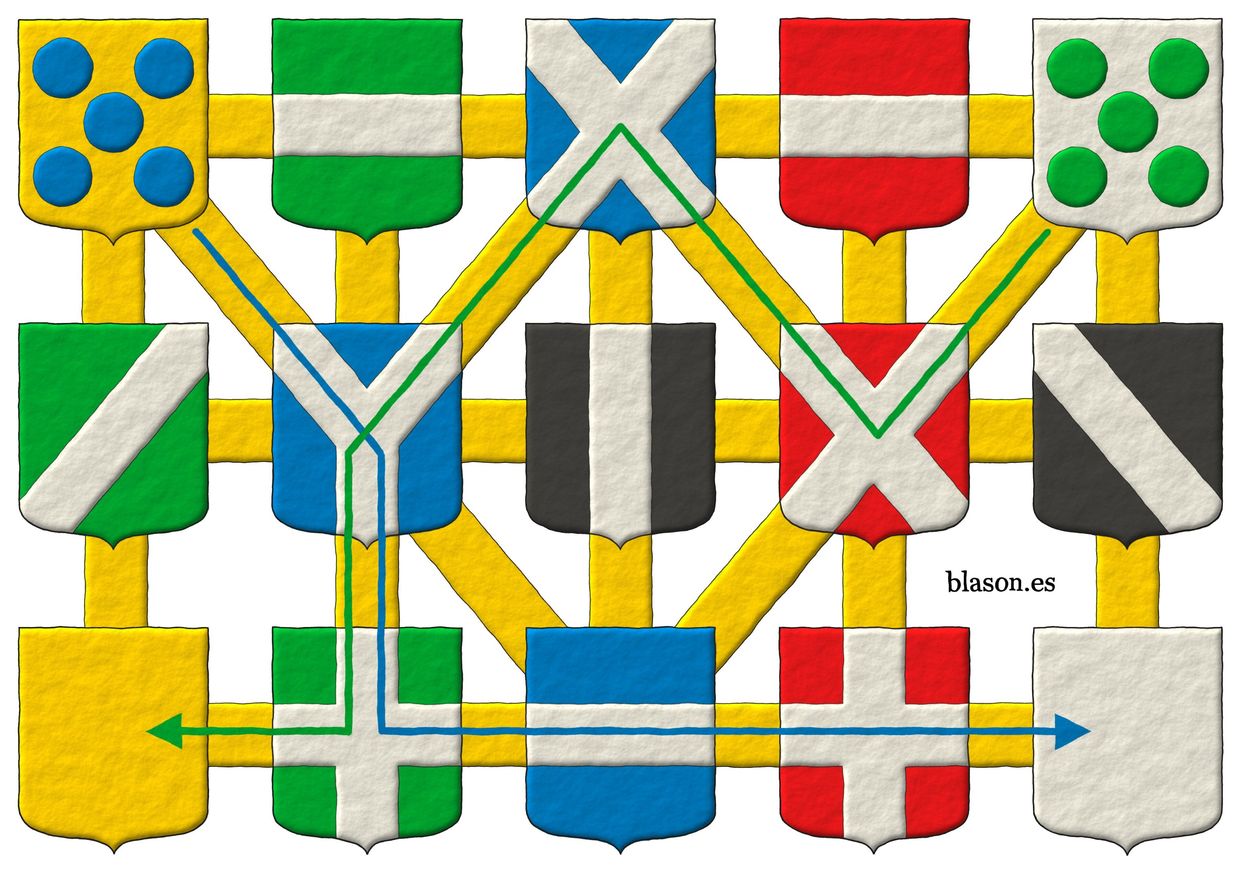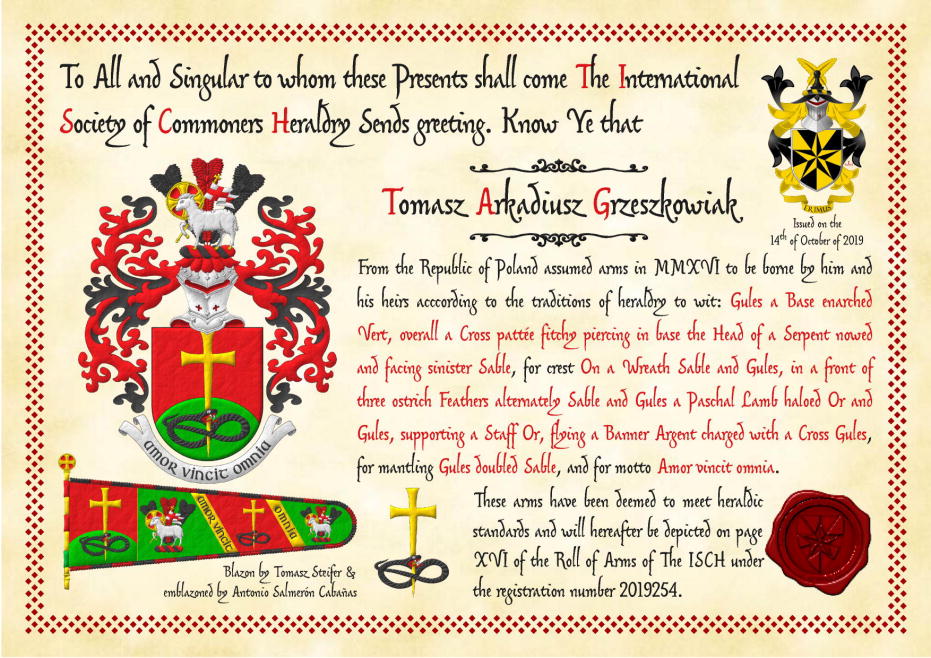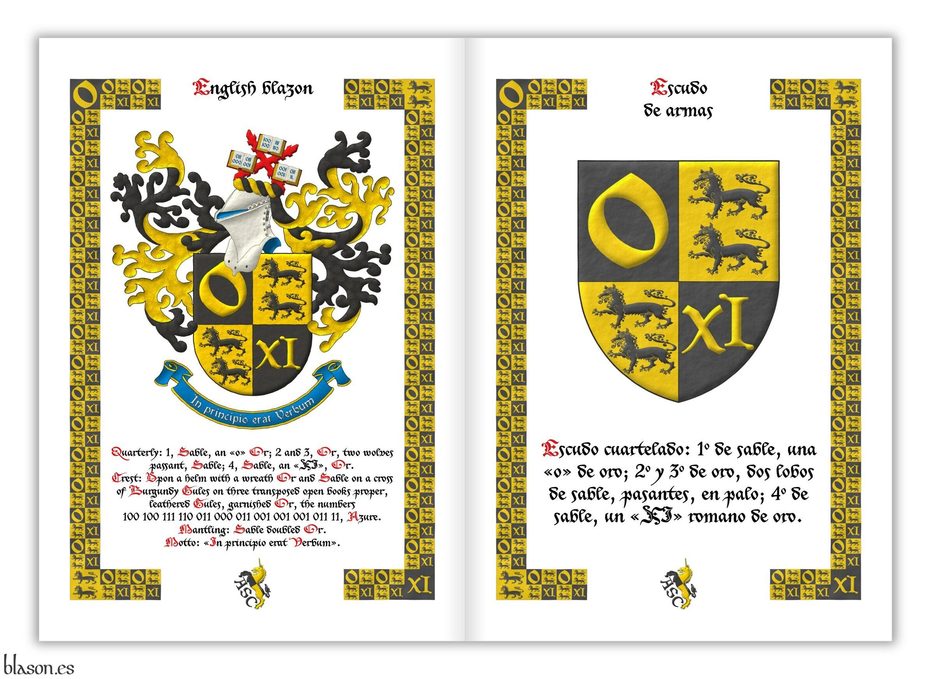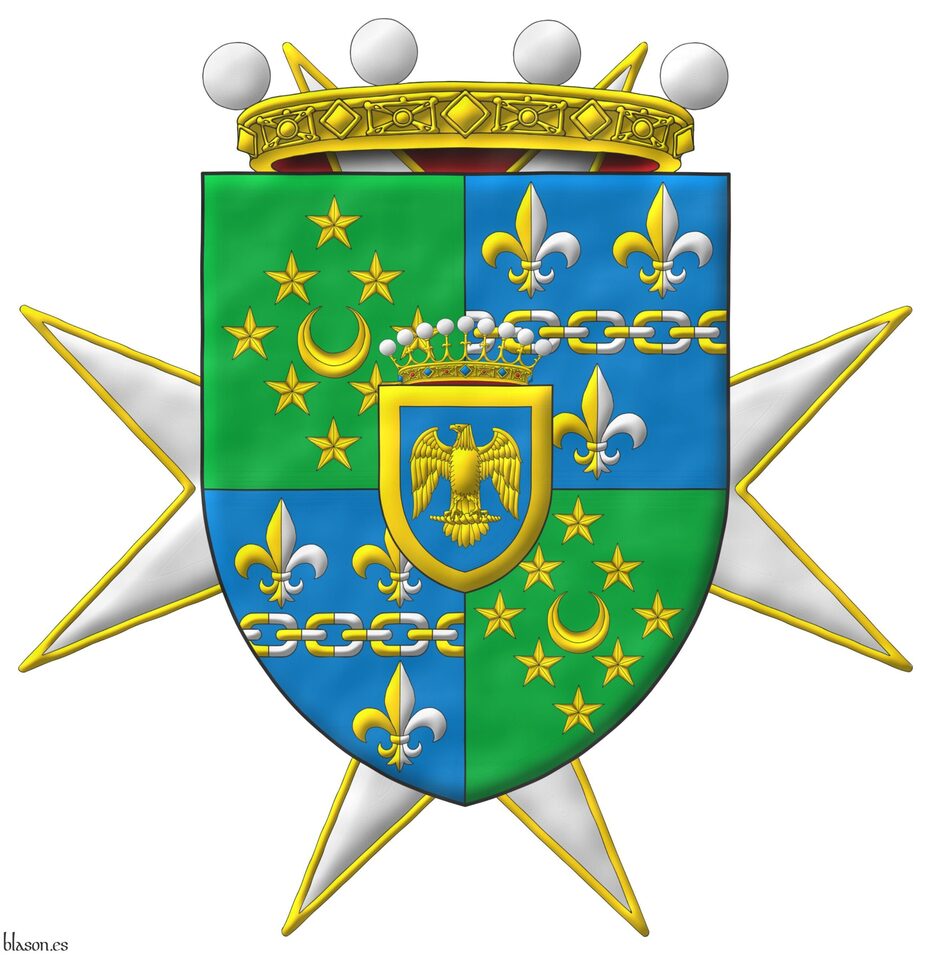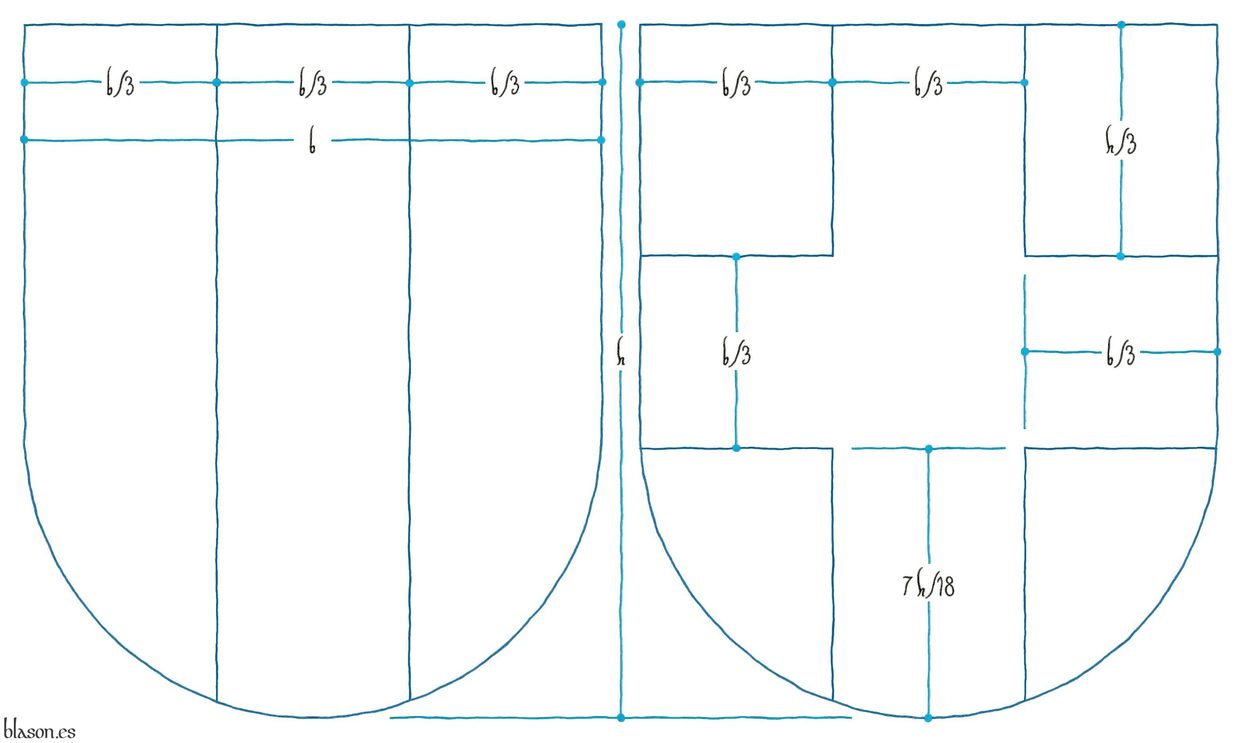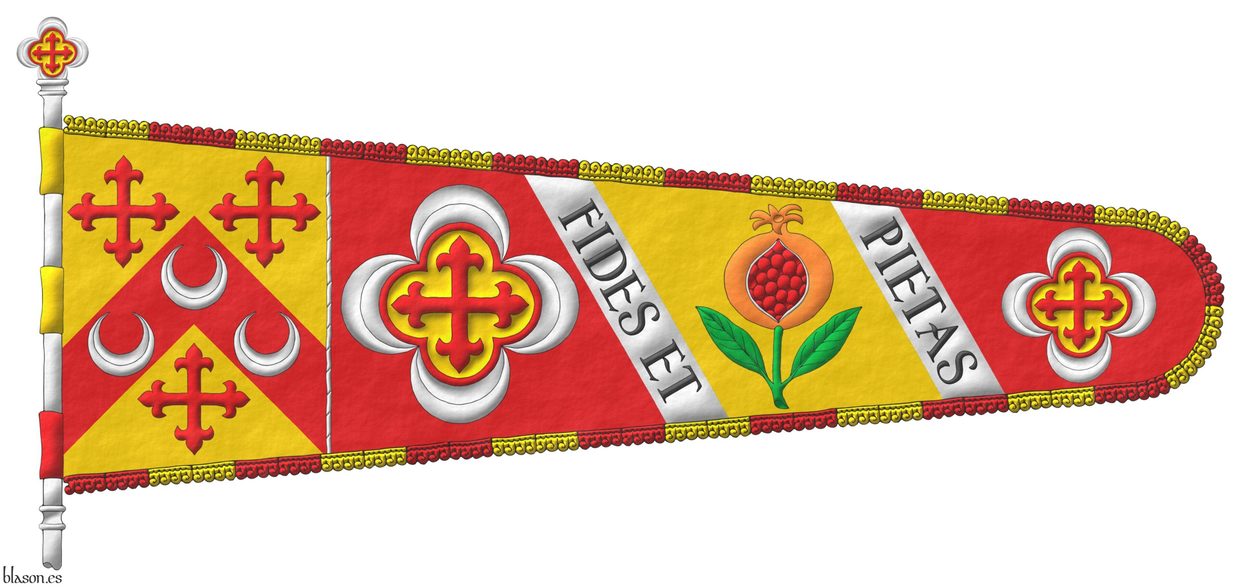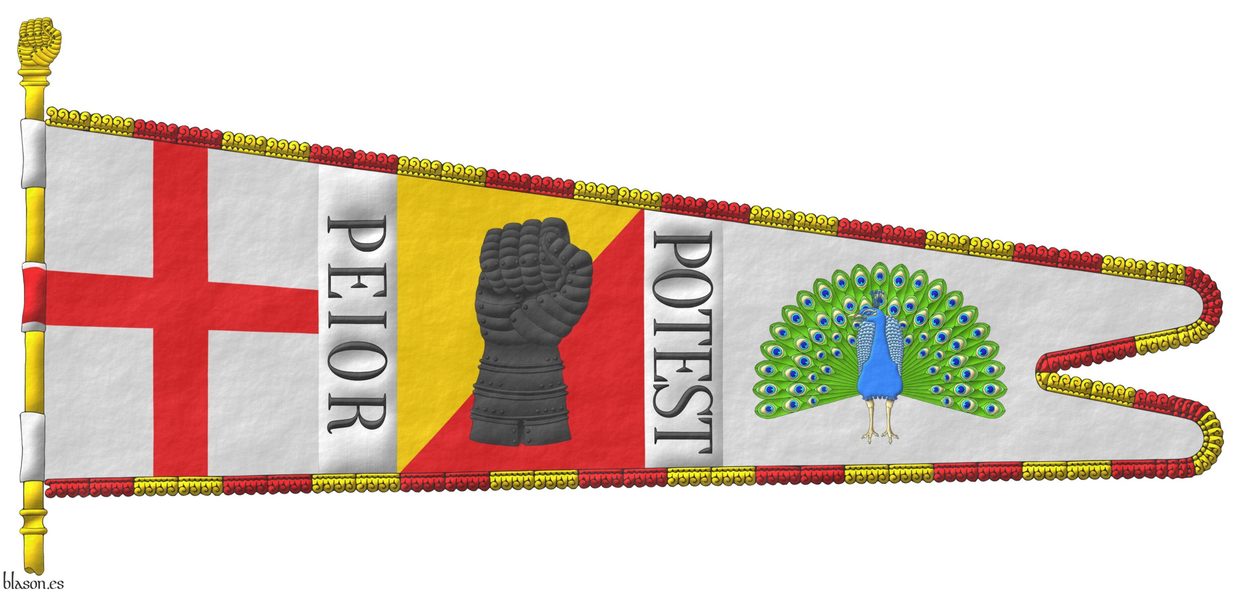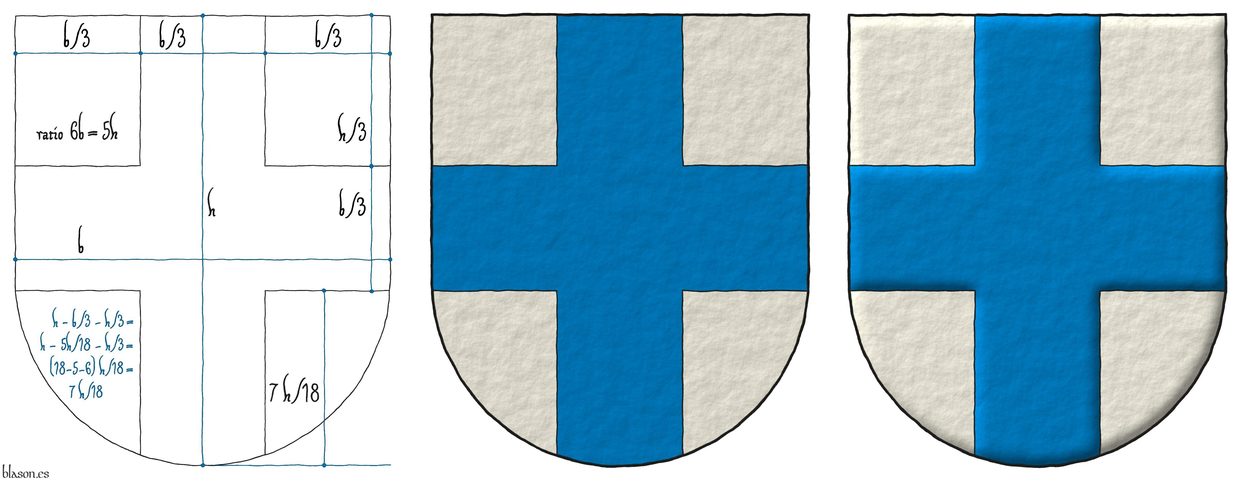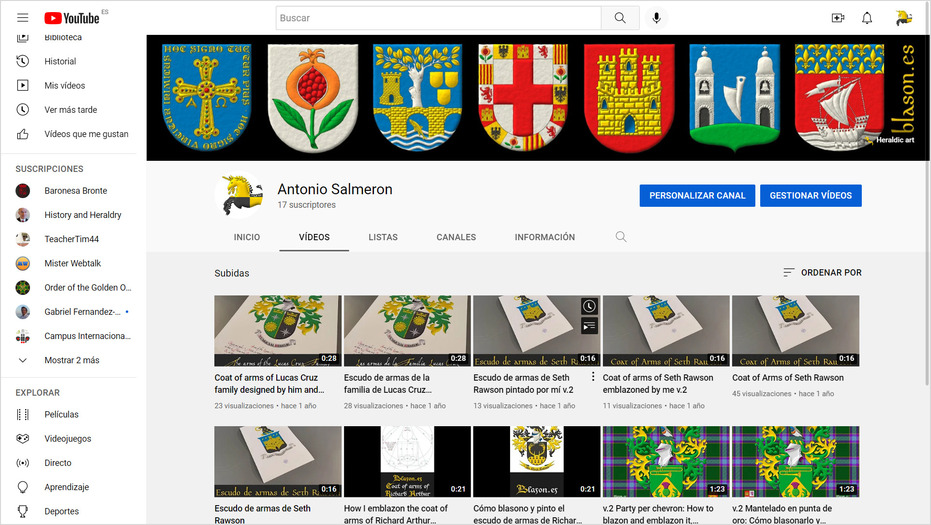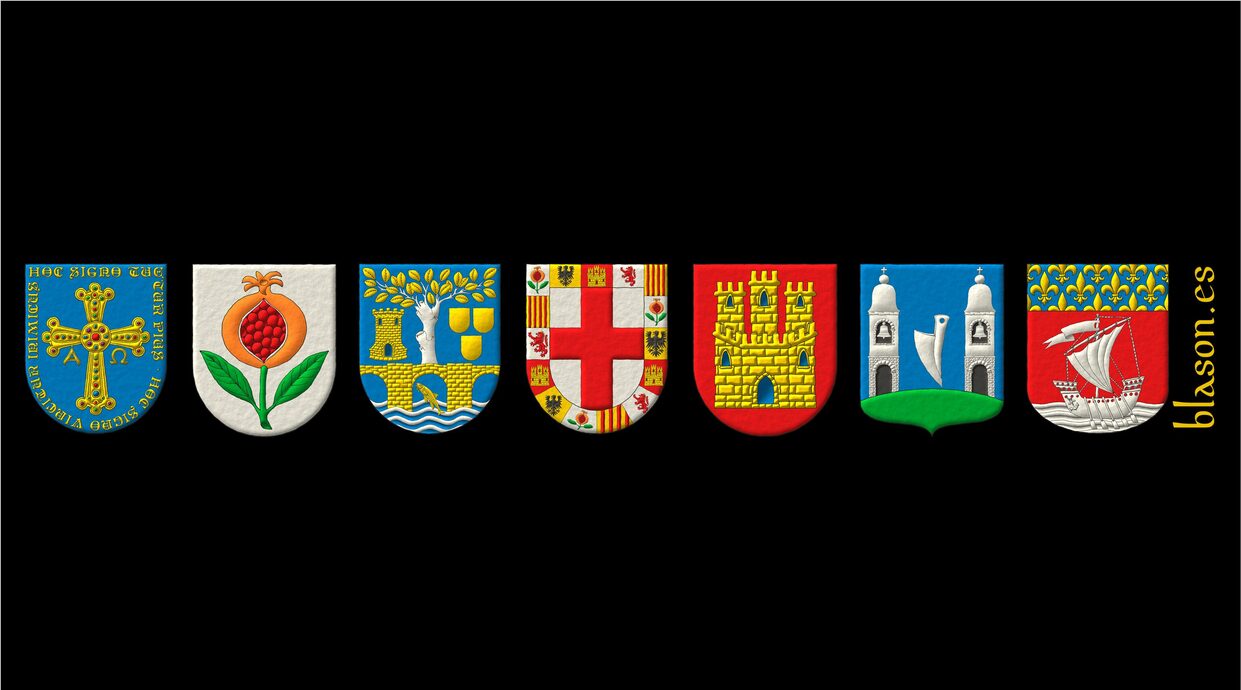Cross

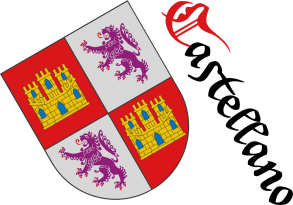
9 coats of arms in the ballroom
There is a series of nine coats of arms in the ballroom of the castle:
- Or, three Fleurs de lis Azure.
- Azure, a Bendsinister Or.
- Or, a Fleur de lis Azure.
- Azure, a Cross Or.
- Or, five Fleur de lis Azure in saltire.
- Azure, a Fess Or.
- Or, two Fleur de lis Azure in bend.
- Azure, a Saltire Or.
- Or, four Fleur de lis Azure.
There are so many Fleurs de lis that everyone, except the joker, calls it the «fleurdelisée» room. Nobody knows the reason why the joker says there is none, do you?
Think before you move the cursor or click on the following link and see the solution.
Categories: Riddle, Or, Azure, Fleur de lis, One, Two, Three, Four, Five, Bend sinister, Cross, Fess and Saltire.


9 coats of arms in the ballroom, solution
Categories: Riddle solution, Ogee, Outlined in sable, Freehand, Or, Azure, Fleur de lis, One, Two, Three, Four, Five, Bend sinister, Cross, Fess and Saltire.


Alarcon of Cantabria, lineage
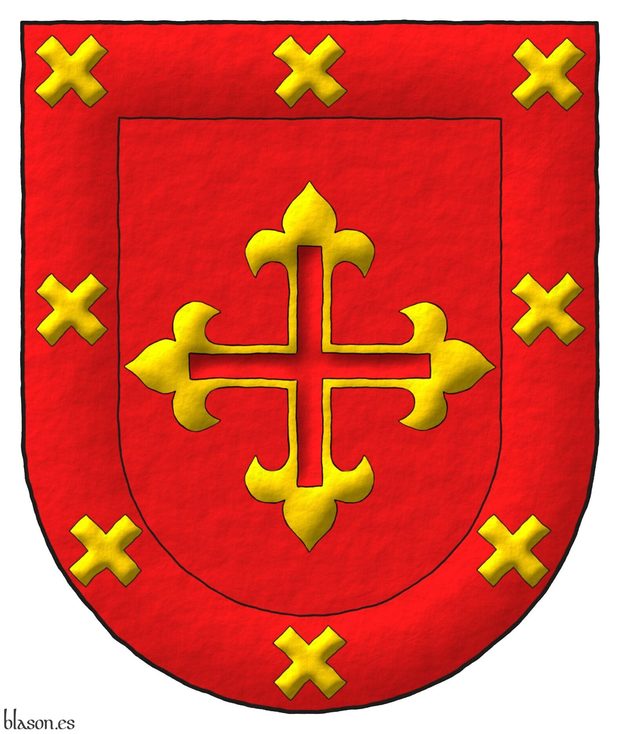
Gules, a cross flory voided Or; within a bordure Gules with eight saltires couped Or.
Escudo de gules, una cruz hueca flordelisada de oro; bordura de gules, ocho sotueres de oro.
Coat of arms painted by me, highlighted with lights and shadows, outlined in Sable, with a semi-circular external shape and with a freehand finishing.
Ancient arms of Alarcon of Cantabria emblazoned by me.
Blazon keywords: Argent, Sable, Or, Gules, Three, Cross, Flory, Voided, Bordure, Saltire and Couped.
Style keywords: Outlined in sable, Illuminated, Semi-circular and Freehand.
Classification: Personal, Interpreted, Boa and Coat of arms.
Bearer: Alarcon of Cantabria, lineage.


![Ver [Alcantara, Order of] en instituciones citadas. Fortaleza de oro y mazonada de sable.](../css/Fortaleza.Institucion.png)
Alcantara, Order of
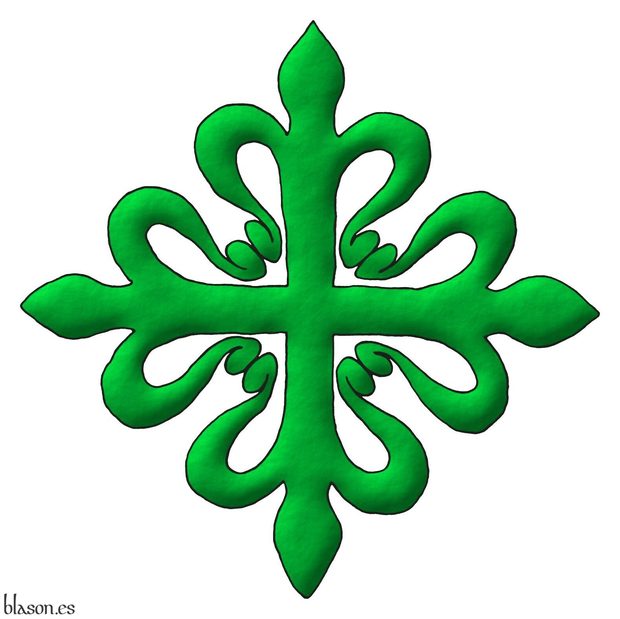
It was founded by Count Henry of Burgundy as a military and religious order, in the year 1093, in Beira Alta, Portugal, near the river Côa with the initial name of «Ordem de São Julião do Pereiro» ~ Order of Saint Julian of Pereiro.
In the year 1214, the defense of the city of Alcantara after its conquest was entrusted to the Order of Calatrava, but in 1218 the Calatravans relinquished it due to Alcantara being far from Calatrava.
To defend Alcantara, King Alfonso IX of León entrusted it to the new Order of the Knights of Saint Julian of Pereiro, requesting in return a certain level of dependency on the Order of Calatrava, which led the Knights of Saint Julian to adopt the Cistercian rule.
Once established in Alcantara, their original name referring to Saint Julian fell into disuse, and by 1253 there were already references to the «masters of the Order of Alcantara», with Saint Julian of Pereiro becoming the foundational center and a secondary commandery of the order.
On the origin and antiquity of the Military Order of Alcantara, and the form of its Commandery
[Avilés, J.; 1780b; treatise IV, chapter V, page 339] describes it as follows: «The Military Order, which we now call of Alcantara, was formerly that of Saint Julian of Pereiro, so named after the place where it was based, along the banks of the river Côa, in the Bishopric of Ciudad-Rodrigo, established in the year 1176 by King Ferdinand II of León, and confirmed in 1177 by Pope Alexander III. And the reason for changing its first name to the second, was because after the Knights of Calatrava had taken the City of Alcantara from the Moors and defended it bravely thereafter, they found it would be difficult to keep it, as their main house was very distant, from which the other Knights and reinforcements could not come whenever needed.».
[Avilés, J.; 1780b; treatise IV, chapter V, page 340] continues by telling us «They discussed this inconvenience with others they had at the time with the King of León, Don Alfonso IX, and it was resolved that the Master of Calatrava would give that town to the Knights of Pereiro so that they might defend it, as they did, under certain conditions in the year 1218, later performing marvels in its defense, earning through their fame and distinguished feats new graces from the Kings; and seeing how essential their residence was, the Knights of Pereiro moved to the town of Alcantara, establishing their Convent there, and thus transformed into Knights of Alcantara, who were previously Knights of Saint Julian of Pereiro».
Categories: Institution, Interpreted, Religious, Military, Illuminated, Outlined in sable, Freehand, Emblem, Cross of Alcantara, Cross couped and Cross.


Almeria, city of

Argent, a cross Gules; a bordure compony of fifteen sections: 1, 6, and 11 Argent, a pomegranate seeded, slipped and leaved proper; 2, 7, and 12 Or, an eagle displayed Sable; 3, 8, and 13 Gules, a castle triple-towered Or, port and windows Gules, masoned Sable; 4, 9, and 14 Argent, a lion rampant Gules, crowned Or; 5, 10, and 15 Or, four pallets Gules.
Escudo de plata, una cruz de gules; una bordura componada de quince compones: 1o, 6o y 11o de plata, una granada al natural, tajada de gules, tallada y hojada de sinople; 2o, 7o y 12o de oro, un águila de sable; 3o, 8o y 13o de gules, un castillo de oro, aclarado de gules, mazonado de sable; 4o, 9o y 14o de plata, un león rampante de gules, coronado de oro; 5o, 10o y 15o de oro, cuatro palos de gules.
Coat of arms emblazoned by me, illuminated with lights and shadows, outlined in Sable, with a semi-circular outer contour and with a iridescent finishing.
Coat of arms of the city of Almeria, Andalusia, emblazoned by me. In 1147, during the Reconquista, the city of Almería was captured by the forces of King Alfonso VII of León, known as «the Emperor», as part of a broader crusading effort declared by Pope Eugene III. The conquest came in response to the Almohad invasion of 1146, which had begun with a landing in Algeciras and quickly seized key territories in the south of the Iberian Peninsula. In reaction, Alfonso VII negotiated an alliance with the Almoravid leader Ibn Ganiya to organize a resistance. He met with Ramon Berenguer IV, Count of Barcelona, and García Ramírez of Navarre, and together they planned the assault on Almería, which at the time was under Almoravid control. Crucial to the success of the operation was the support of the powerful Genoese navy, as well as French crusaders who had responded to the papal call. Subsequently, in recognition of Genoa’s decisive role in the campaign, Almería adopted as the central element of its coat of arms the Genoese emblem: «Argent, a cross Gules».
Blazon keywords: Argent, Gules, Or, Sable, Vert, One, Four, Fifteen, Cross, Bordure, Compony, Pomegranate, Slipped, Leaved, Proper, Eagle, Castle, Triple-towered, Port and windows, Masoned, Lion, Rampant, Crowned and Pallet.
Style keywords: Outlined in sable, Illuminated, Semi-circular and Iridescent.
Classification: Civic, Interpreted, Boa and Coat of arms.
Bearer: Almeria, city of.


Arithmetic
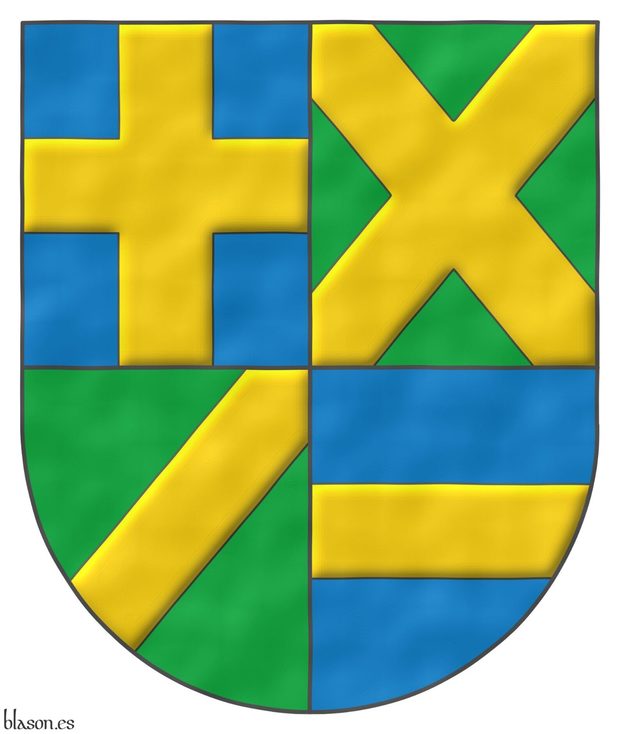
Quarterly: 1 Azure, a cross Or; 2 Vert, a saltire Or; 3 Vert, a bend sinister Or; 4 Azure, a fess Or.
Escudo cuartelado: 1o de azur, una cruz de oro; 2o de sinople, un sotuer de oro; 3o de sinople, una barra de oro; 4o de azur, una faja de oro.
Imaginary coat of arms that I have created featuring: a semicircular external shape; a field enamelled with flat azure and green inks; all pieces in metal Or, outlined in Sable and illuminated; and the entire design finished with a watercolor effect.
This coat of arms symbolizes the fundamental area of mathematical science, whose object of study is numbers and the elementary operations that can be performed with them: addition, subtraction, multiplication, and division.
Blazon keywords: Quarterly, Azure, Vert, Or, Cross, Saltire, Bend sinister and Fess.
Style keywords: Illuminated, Outlined in sable and Watercolor.
Classification: Created, Imaginary and Coat of arms.
Imaginary bearer: Arithmetic.


Bailleul, commune of
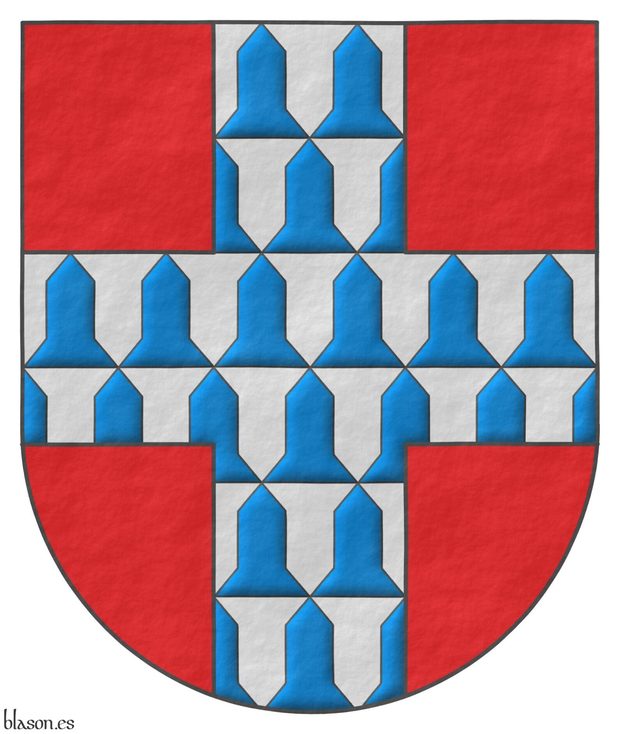
Gules, a cross vair.
Escudo de gules, una cruz de veros.
Coat of arms interpreted with: a semicircular (round) base; the field in flat tincture of Gules; the vair illuminated and outlined in Sable; and the whole with a roughened finish.
The commune of Bailleul is located in the district of Dunkirk, in the Nord department, in the Nord–Pas-de-Calais region of France.
The coat of arms of Bailleul, called «Belle» in Flemish, is similar to that of the heraldist Gonzalo Argote de Molina, differing in that the commune’s arms bear vair, while the heraldist’s arms bear rounded vair in the ancient style.
Blazon keywords: Without divisions, Gules, Argent, Azure, Cross and Vair.
Style keywords: Semi-circular, Illuminated, Outlined in sable and Rough.
Classification: Interpreted, Civic, Coat of arms and Kingdom of France.
Bearer: Bailleul, commune of.


![Ver [Calatrava, Order of] en instituciones citadas. Fortaleza de oro y mazonada de sable.](../css/Fortaleza.Institucion.png)
Calatrava, Order of
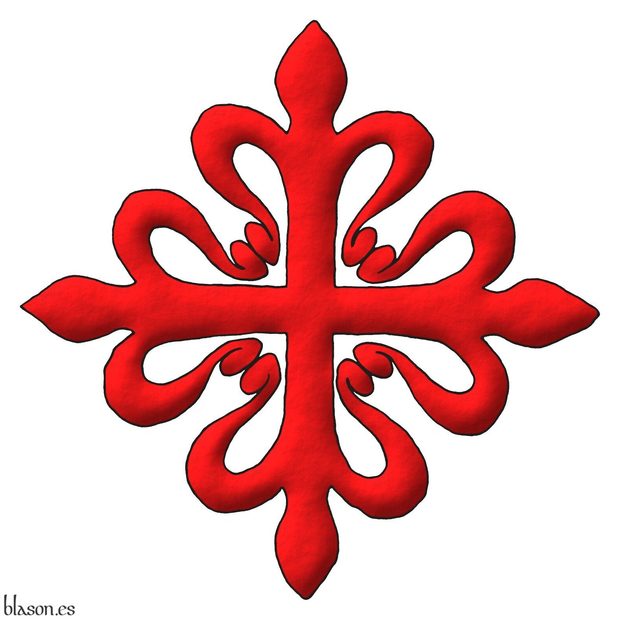
The Order of Chivalry of Calatrava is both military and religious, founded in the Kingdom of Castile during the 12th century by Abbot Raymond of Fitero.
The purpose of its foundation was the protection of the town of Calatrava la Vieja, which currently belongs to the municipality of Carrión de Calatrava in Ciudad Real. At the time of the order's foundation, it was an important city, in the middle valley of the river Guadiana and with a strategic position, as it was a necessary passage on the road from Toledo to Córdoba to Toledo and between the west and east of the Iberian Peninsula.
On the origin and antiquity of the Military Order of Calatrava, and the form of its Commandery
[Avilés, J.; 1780b; treatise IV, chapter IV, pages 334] writes «The Military Order of Calatrava was instituted by Don Sancho III, King of Castile (called the Desired), in the year 1158, while he was visiting his Kingdom; and being in Toledo with news of the great army that the Moors were gathering to besiege Calatrava la Vieja (which is called so today to distinguish it from the new one, which was founded later); and as the Templars, to whom this Fortress belonged, did not have sufficient power to resist such a large multitude, they handed it over to King Don Sancho himself so that he could take charge of it, as he did».
[Avilés, J.; 1780b; treatise IV, chapter IV, page 335] continues by telling us «The Abbot of Santa María de Fitero», near the river Pisuerga as he will indicate next, «of the Congregation of Cistercian, in the Bishopric of Palencia (which is a Monastery of St. Bernard, located on the river Pisuerga), named Don Raymond, and Friar Diego Velazquez, his subject Monk, who followed the Court, despite the difficulty of the enterprise, requested it from the King to defend it, which was granted, trusting in the virtue of the Abbot, and the strength of the Monk, who had previously been a great Knight in deeds of Arms, and very practiced in war».
[Avilés, J.; 1780b; treatise IV, chapter IV, page 336] continues «Seeing themselves in such an obligation, and that by themselves they could not fulfill it, they turned to Archbishop Don Juan (who was the fourth of Toledo) for help; and he, granting many indulgences in all his Archbishopric to those who, for themselves and for others, supplied the Place with provisions, in the same way as those who, unable to go due to old age or illness, helped with weapons, horses, and men; and having spread this news, so much help came to them, that when the Moors learned that the number of people exceeded twenty thousand men, they abandoned the conquest, returning to their homes: for this reason, the King ceded the Town of Calatrava to the Abbot of Fitero, and his successors, to defend it from the Moors from then on, confirmed later by King Alfonso IX, his son».
[Avilés, J.; 1780b; treatise IV, chapter IV, page 337] concludes «Having obtained this grace, Abbot Don Raymond brought the most suitable Monks from Fitero to Calatrava, and everything else that was necessary for living and for the defense of the Town and its land, which with the people inclined to war who remained, formed the Order of Chivalry of Calatrava, taking this name from the place where the institution was made, which in Arabic Calatrava means Castle».
Categories: Institution, Interpreted, Religious, Military, Illuminated, Outlined in sable, Freehand, Emblem, Cross of Calatrava, Cross couped and Cross.


Carlos Vidriales, certification, pages 6 and 7
Arms of Carlos Vidriales García Bustamante painted by me in the Certification of the King of Arms of Castile and Leon Alfonso de Ceballos-Escalera and Gila, Marquess of La Floresta, Viscount of Ayala and grand of Spain. The image shows the pages 6 and 7 of this certification.
Credits: Alfonso de Ceballos-Escalera y Gila is the author of the certification of arms and Antonio Salmerón y Cabañas is the author of the heraldic art for the certified coat of arms.
Categories: Certification, Heraldic document, Coat of arms, Interpreted, Personal, Semi-circular, Illuminated, Outlined in sable, Party per pale, Argent, Cross, Sable, Bordure, Motto, Or, Thirteen, Hurt, Hurt, torteau, pellet, pomme and golpe, Azure, Three, In pale, Four, Five, Chief, Fleur de lis, Lineage, Conjoined in fess, Decoration, Suspended and Base (lower 1/3).
Root: Vidriales García y Bustamante, Carlos.


Cavalry Regiment Alcantara, Laureate of Saint Ferdinand
Grand Laureate Cross of Saint Ferdinand.
Argent, a cross of Alcantara. Crest: A closed royal crown Or, with eight arches, visible five. Behind the shield the Laureate Grand Cross of Saint Ferdinand. Motto: «Hoec nubila tollunt obstantia sicut sol».
Escudo de plata, una cruz de Alcántara. Timbrado de una corona real cerrada. Acolada detrás del escudo la gran cruz laureada de San Fernando. Lema: «Hoec nubila tollunt obstantia sicut sol».
Coat of arms interpreted in the following manner: the shape of the shield is of a semicircular arch; the field is illuminated in metal Argent; the cross of Alcantara, the 4 swords and the 2 laurel branches are outlined in Sable and illuminated in Vert and Gules; the royal crown is closed, outlined in Sable and illuminated with the metal Or, Argent for the pearls, Azure and Or for the orb, Gules and Vert for the gems, Gules for the inner cloth, and Sable for the visible hollow at its base; and the whole has a iridescent finish.
Rif War, July 23, 1921, banks of the Igan River, North Africa
The Alcantara Regiment executed nine successive cavalry charges to protect the infantry's retreat, nine charges until they broke the enemy lines, outnumbering them. The last charge was on foot because all their horses were dead or exhausted. These heroic riders of Alcantara had fulfilled their duty of protecting the wounded infantry in their retreat to El Batel, but the price was appalling: of 691 riders, only 67 survived, and three months were necessary to recover hundreds of corpses.
For this reason, in 2012, the Alcántara Regiment was collectively awarded the Grand Laureate Cross of Saint Ferdinand.
Two lances behind the shield
Since 1987, the coat of arms of the cavalry regiments of the Spanish Army must carry two crossed lances accolade behind the shield. And indeed, this coat of arms of the Alcántara Cavalry Regiment has two lances behind the shield, but in my artistic heraldic interpretation, I did not paint them to avoid detracting from the prominence of the Laureate Cross.
Blazon keywords: Without divisions, Argent, Cross of Alcantara, Cross couped, Cross, Crest, Closed royal crown, Crown, Behind the shield, Four, Sword, Crosswise, Gules, Two, Branch, Laurel, Vert and Motto.
Style keywords: Semi-circular, Illuminated, Outlined in sable and Iridescent.
Classification: Interpreted, Military, Army and Navy and Coat of arms.
Bearer: Alcantara, Cavalry Regiment.


Cavalry Regiment Montesa, royal crown
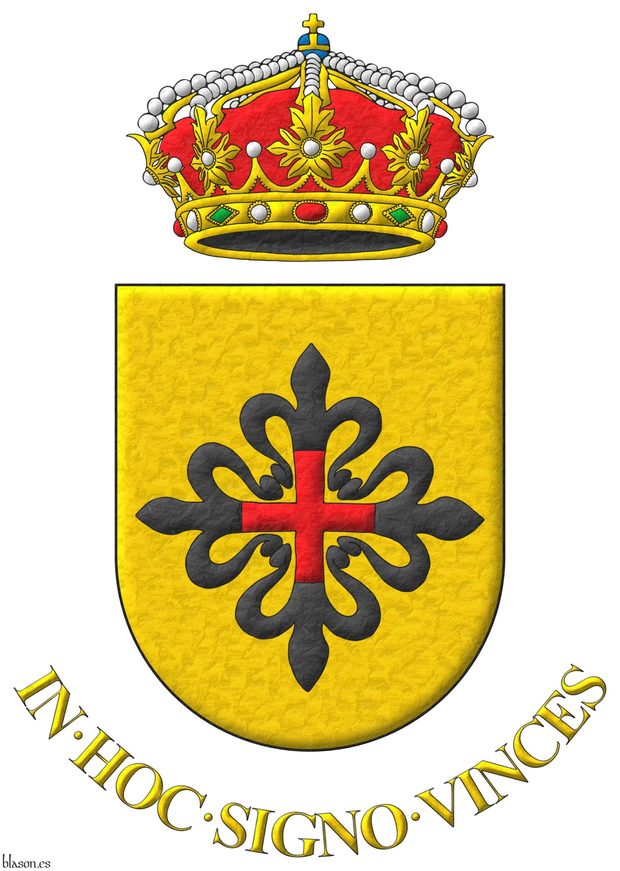
In this sign, you shall conquer.
Argent, a cross of Montesa. Crest: A closed royal crown Or, with eight arches, visible five. Motto: «In hoc signo vinces».
Escudo de oro, una cruz de Montesa. Timbrado de una corona real cerrada. Lema: «In hoc signo vinces».
Coat of arms interpreted as follows: the shape of the shield is a semi-circular arch; the field has been illuminated in metal Or; the cross of Montesa is outlined in Sable and illuminated in Sable and Gules; the royal crown is closed, outlined in Sable and illuminated the metal in Or, the pearls in Argent, the orb in Azure and Or, the gemstones in Gules and Vert, the inner cloth in Gules, and the visible hollow at its base in Sable; and the whole has a slightly beaten metal finish.
Regimental Motto
The Latin motto «In hoc signo vinces» is translated as «In this sign, you shall conquer».
Globus cruciger ~ Orb
It is called orb ~ «globus cruciger», the first in Spanish and the second in Latin, referring to the part of the royal crown, a jewel, or a jewel itself that recreates the shape of the globe topped with a cross.
Blazon keywords: Without divisions, Or, Cross of Montesa, Cross couped, Cross, Crest, Closed royal crown, Crown and Motto.
Style keywords: Semi-circular, Illuminated, Outlined in sable and Soft metal.
Classification: Interpreted, Military, Army and Navy and Coat of arms.
Bearer: Montesa, Cavalry Regiment.


![Ver [Coat of Arms of Ugnius Mikucionis in Twelve Lineages] en enlaces recomendados. Áncora de oro y la divisa enlace.](../css/Ancora.Enlace.png)
Coat of Arms of Ugnius Mikucionis in Twelve Lineages
Publication of my interpretation of the arms of Ugnius Mikucionis, on the blog Twelve Lineages of Soria with the article titled: The eminent heraldist Mr. Antonio Salmerón Cabañas interprets the coat of arms of Ugnius Mikucionis (Lithuania and Norway).
Blazon in Spanish by Alfonso de Ceballos-Escalera y Gila, Chronicler of Arms of Castile and León, from his certification of arms: «Vert, a Latin cross made of a wooden staff, raguly, from whose sinister flank issues a leafy branch that encircles the cross from above and entwines over its base, all Or. Crested with a steel helmet affronty, torse Or and Vert, with mantling Vert doubled Or. For crest, the same raguly Latin cross, branched and leafed, Or, placed before two wings Vert».
Blazon in English by The South African Bureau of Heraldry, from its certification of arms: «Vert, a wooden staff, its upper end terminating in a Latin cross, raguly, couped at random, issuant from its sinister nombril point a leaved offshoot encircling the cross, its end terminating and debruising the lower limb Or. Crest: In front of a pair of wings displayed Vert, a wooden staff issuant, its upper end terminating in a Latin cross, raguly, couped at random, issuant from its sinister nombril point a leaved offshoot encircling the cross, its end terminating and debruising the lower limb Or. Wreath and mantling: Vert and Or». I do not agree with the specification of the exact place of origin of the branch, the «nombril point» ~ «navel», because that point of origin does not distinguish this coat of arms from another where the branch could emerge at a different height, either closer or further from the point of the shield, and because it forces the artistic interpretation to either break the rule of fullness or to draw a curved branch in a panache shape to allow it to open before gaining height.
Note how in the Spanish certification of arms, by the Chronicler of Arms of Castile and León, this unnecessary nombril specification as the origin point of the branch is omitted.
The nombril is the exact crossing point of the vertical axis of symmetry of the shield with the lower edge of the bend.
Categories: Link, Vert, One, Cross, Raguly, Sinister, Or, Helm, Wreath, Mantling, Crest, Two, Wing and At the nombril.
Root: Twelve Lineages of Soria.


Crest and mantling of Brady Brim-DeForest
Party per chevron Gules and Argent, two acorns slipped Or and in base a fleur de lis Azure. Crest: Upon a helm befitting his degree, with a wreath Or and Sable, a demi-lion Or, armed and langued Azure, holding in its paws a swallow-tailed pennon Azure, charged with a cross patty Argent. Mantling: Gules doubled Argent.
Arms painted by me, highlighted with lights and shadows, outlined in Sable, with a double pointed outer contour and with a leather finishing.
Blazon keywords: Gules, Or, Argent, Azure, Two, One, Party per chevron, Acorn, Slipped, Base, Fleur de lis, Crest, Upon (wreath), Helm, Demi, Lion, Armed, Langued, Grasping, Paw, Charged, Cross and Patty.
Style keywords: Outlined in sable, Illuminated, Double pointed and Leather.
Classification: Personal, Interpreted, Boa, Coat of arms, Pennon and Flag.
Bearer: Brim-DeForest, Brady.


Crest, mantling and motto of Julio Hector Aspe
Azure, a trumpet bend sinisterwise Or, debruised by a fish haurient Argent, debruised by a sword bendwise point downwards Or, all between two fleurs de lis in fess Argent. Crest: Upon a helm lined Gules with a wreath Or and Azure, a paschal lamb regardant Argent, nimbed Or, supporting a staff Or, flying a flag Argent charged with a cross Gules. Mantling: Azure doubled Or. Motto: «Quis ut Deus».
Coat of arms designed by me, illuminated with lights and shadows, outlined in Sable, with an ogee triple-pointed external shape and with a watercolor finishing.
Blazon keywords: Azure, Argent, Or, Gules, Sable, One, Two, Trumpet, Bend sinisterwise, Debruised, Fish, Haurient, Sword, Point downwards, Between, Fleur de lis, In fess, Crest and mantling, Crest, Upon (wreath), Helm, Wreath, Paschal lamb, Regardant, Nimbed, Grasping, Shafted, Charged, Cross, Mantling and Motto.
Style keywords: Outlined in sable, Illuminated, Ogee Triple-Pointed and Watercolor.
Classification: Personal, Created, Boa, Coat of arms and Flag.
Bearer: Aspe, Julio Hector.


Crest, mantling and motto of the family Simon-Faus
Quarterly: 1 Argent, an oak eradicated Vert, fructed Or; 2 Azure, a tower with a turret Or, port and windows Azure, masoned Sable; 3 Azure, a hound passant Argent, spotted Sable; 4 Argent, a cross Gules. Crest: Upon a helm with a wreath Argent and Azure, five ostrich feathers alternately Azure and Argent. Mantling: Azure doubled Argent. Motto: «Ut Ferrum Fortes» Sable, with initial letters Gules, over a scroll Argent.
Coat of arms devised by me, illuminated with lights and shadows, contoured in Sable, with an ogee external shape and with a leather finishing.
Design rationale
The oak tree laden with acorns Or in the first quarter symbolizes the family's fertility. The oak and the domed tower in the second quarter, in their transformed forms, are elements from the coat of arms of the Simon lineage, which they represent. The third quarter derives from the arms of the Faus family and represents it. The plain cross in the fourth quarter is a symbol of Christ and of Aragon. The Latin motto reads: «Strong as Iron».
Blazon keywords: Argent, Vert, Or, Azure, Sable, Gules, One, Five, Quarterly, Oak, Tree, Eradicated, Fructed, With a turret, Port and windows, Masoned, Dog, Passant, Spotted, Cross, Crest and mantling, Crest, Upon (wreath), Helm, Wreath, Ostrich feathers, Alternately, Mantling and Motto.
Style keywords: Outlined in sable, Illuminated, Ogee and Leather.
Classification: Personal, Created, Design rationale, Boa and Coat of arms.
Bearer: Simon-Faus, family.


Crest, mantling and motto of the Lord of South Clifton
Sable, a tyger rampant Argent; a bordure Argent charged with eight crosses crosslet fitchy Sable. Crest: Upon a helm affronty lined Gules, issuant from a crown of Knight, a cross patty Gules. Mantling: Sable doubled Argent. Motto: «Acta Non Verba» over a scroll Argent doubled Gules.
Coat of arms interpreted by me, illuminated with lights and shadows, contoured in Sable, with a pointed outer contour and with a watercolor finishing.
Blazon keywords: Sable, Argent, Gules, One, Eight, Tyger, Rampant, Bordure, Charged, Cross crosslet fitchy, Crest, Upon (wreath), Helm, Affronty, Lined, Issuant, Crown of Knight, Crown, Cross, Patty, Mantling, Motto, Scroll and Doubled.
Style keywords: Outlined in sable, Illuminated, Pointed and Watercolor.
Classification: Personal, Interpreted, Boa and Coat of arms.
Bearer: South Clifton, Lord of.


Cross potent, cross moline, and cross of Jerusalem, comparison
A Gules and Or comparison between cross potent, cross moline, and cross of Jerusalem
Blazon keywords: Gules, Or, Cross potent, Cross couped, Cross moline, Cross of Jerusalem and Cross.
Style keywords: Freehand, Outlined in sable and Illuminated.
Classification: Schema.


Five hurts and five pommes
Transform the blazon «Or» into «Or, five Pommes in saltire» and the blazon «Argent» into «Argent, five Hurts in saltire» moving the pommes and hurts through both metals, without breaking the rule of tinctures.
You can change one charge by another one, but only once.
For example, if you change «Sable, a Bend Argent» by «Sable, a Pale Argent», then the Pommes can arrive to «Or» blazon. However, this is not a solution, because the Hurts cannot walk to «Argent» blazon.
Think before you move the cursor or click on the following link and see the solution.
Categories: Riddle, Ogee, Outlined in sable, Freehand, Or, Argent, Vert, Azure, Gules, Sable, Hurt, torteau, pellet, pomme and golpe, Hurt, Pomme, In saltire, Fess, Saltire, Bend sinister, Cross, Pale and Bend.


Five hurts and five pommes, solution
For example, if you change «Azure, a Cross Argent» by «Azure, a Pall Argent», then the Pommes can arrive to «Or» blazon and the Hurts can arrive to «Argent» blazon. You can view both paths azure and vert in the following image.
Other solution is to change «Azure, a Cross Argent» by «Azure, a Bordure Argent».
Categories: Riddle solution, Ogee, Outlined in sable, Freehand, Or, Argent, Vert, Azure, Gules, Sable, Hurt, torteau, pellet, pomme and golpe, Hurt, Pomme, In saltire, Fess, Saltire, Bend sinister, Cross, Pale, Bend and Pall.


Full achievement of the Reverend John Muscat
Argent, a tree eradicated proper, in chief an escallop reversed Gules, between two flies pilewise proper. Crest: A galero Sable with two cords, one on each side, each with six tassels Gules. Motto: «No Fear In Love». Behind the shield, the cross of the Holy Sepulchre of Jerusalem. The shield is surrounded by the cross of a Knight Commander of the Holy Sepulchre of Jerusalem.
Arms interpreted by me, highlighted with lights and shadows, contoured in Sable, with a pointed external shape and with a freehand finish.
G0117, Chief Herald of Arms of Malta's grant for the arms of the Reverend John Muscat, Honorary Monsignor of the Canon Chapter, Roman Catholic Cathedral of the Assumption, Gozo. These arms have been emblazoned by me for such grant.
Blazon keywords: Argent, Gules, One, Two, Six, Tree, Eradicated, Proper, In chief, Escallop, Between, Fly, Pilewise, Crest, Galero, Cord, Tassel, Motto, Behind the shield, Cross, Surrounded and Decoration.
Style keywords: Outlined in sable, Illuminated, Pointed and Freehand.
Classification: Religious, Interpreted, Boa and Coat of arms.
Bearer: Muscat, John.


Gonzalo Argote de Molina
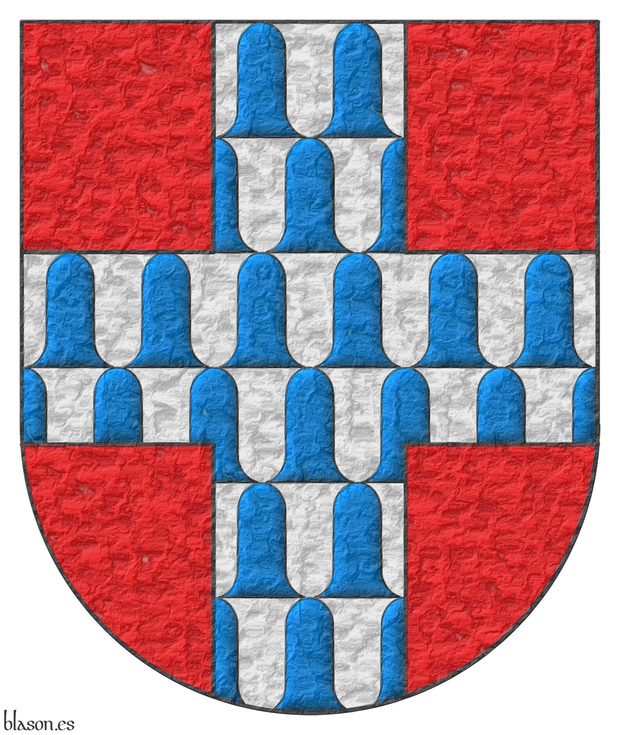
Gules, a cross vair ancient.
Escudo de gules, una cruz de veros antiguos.
Coat of arms that I have interpreted as follows: the shield has a semicircular (round) base; the field is in flat tincture of Gules; the vair ancient, rounded in the old style, are outlined in Sable and illuminated; and the whole has a raised-stroke drawing.
The coat of arms of the commune of Bailleul is very similar to this coat of arms, with the difference that it is of regular vair instead of ancient, rounded vair, like that borne by Gonzalo Argote de Molina.
Blazon keywords: Without divisions, Gules, Argent, Azure, Cross and Vair ancient.
Style keywords: Semi-circular, Illuminated, Outlined in sable and Metal beaten.
Classification: Interpreted, Personal, Coat of arms and Heraldry and heralds.
Bearer: Argote de Molina, Gonzalo.


Halkosaari, Heikki

Argent, an apple tree, the base of its trunk forming a cross crosslet Azure, fructed Gules.
Escudo de plata, un manzano con la punta del tronco en forma de cruz recrucetada de Azur, frutado de gules.
Coat of arms painted by me, highlighted with lights and shadows, contoured in Sable, with a semi-circular external shape and with a iridescent finishing.
Blazon keywords: Argent, Azure, Gules, One, Apple tree, Base, Trunk, Cross, Crosslet, Cross couped and Fructed.
Style keywords: Outlined in sable, Illuminated, Semi-circular and Iridescent.
Classification: Personal, Interpreted, Boa and Coat of arms.
Bearer: Halkosaari, Heikki.


ISCH Certification for Tomasz Arkadiusz Grzeszkowiak
The Commoners' Certification of Arms for Tomasz Arkadiusz Grzeszkowiak, arms designed by Tomasz Steifer and emblazoned by me.
Gules, a base enarched Vert, overall a cross patty fitchy Or, piercing in base the head of a serpent nowed and facing sinister Sable, langued Gules. Crest: Upon a helm affronty, with a wreath Sable and Gules, in a front of three ostrich feathers alternately Sable and Gules a paschal lamb Argent, haloed Or and Gules, supporting a staff Or, flying a banner Argent charged with a cross Gules. Mantling: Gules doubled Sable. Motto: «Amor vincit omnia»
In the blazon of this certification, I wrote the expression «a Base enarched Vert», it is correct. But the expression «a Mount Vert» it is also possible. In the original expression in the Polish blazon is «na zielonym wzgórkuon» ~ «the green hill».
Blazon keywords: Without divisions, Gules, One, Mount, Vert, Issuant from base, Overall, Cross patty fitchy, Cross couped, Piercing, Head, Serpent, Nowed, Facing sinister, Sable, Langued, Helm, Affronty, Two, Mantling, Doubled, Wreath, Three, Quill, Alternately, Debruised, Paschal lamb, Argent, Nimbed, Or, Grasping, Shafted, Charged, Cross and Motto.
Classification: Interpreted, Personal, Certification, Heraldic document and Flag.
Bearer: Grzeszkowiak, Tomasz Arkadiusz.


Jamilena
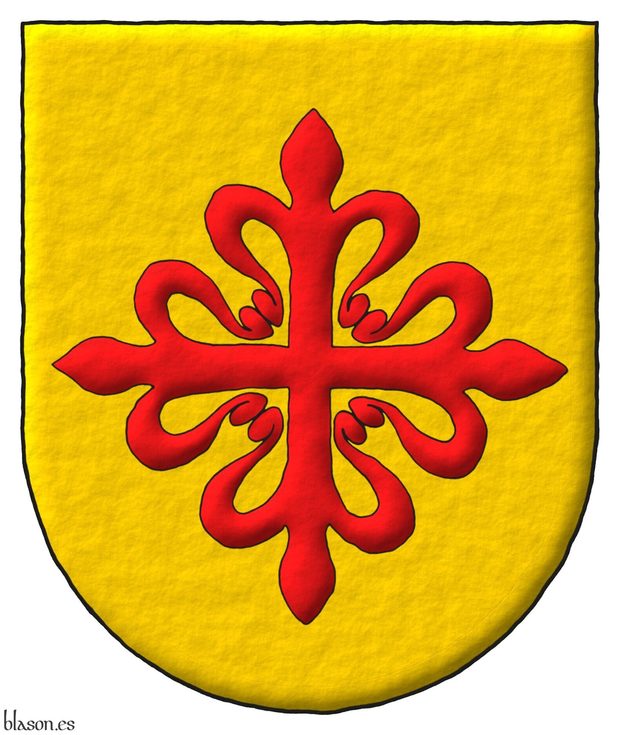
Coat of arms of the municipality of Jamilena, province of Jaén.
Or, a cross of Calatrava.
Escudo de oro, una cruz de Calatrava.
Coat of arms interpreted as follows: the shield's shape is a semicircular arch; the field is illuminated in metal Or; the cross of Calatrava is outlined in Sable and illuminated in Gules; and the entire piece has a rough line finish.
Blazon keywords: Without divisions, Or, Cross of Calatrava, Cross couped and Cross.
Style keywords: Semi-circular, Illuminated, Outlined in sable and Freehand.
Classification: Interpreted, Civic and Coat of arms.
Bearer: Jamilena.


McMillan Bell of Auchinreoch, Andrew Ronald

Gules, a cross Argent charged with four ermine spots in cross Sable, in the dexter of the chief a lion’s head erased Or.
Escudo de gules, una cruz de plata cargada de cuatro colas de armiño en cruz, en la diestra del jefe una cabeza de león arrancada de oro.
Arms interpreted by me, highlighted with lights and shadows, outlined in Sable, with a pointed external shape and with a freehand finish.
G0116, Chief Herald of Arms of Malta's grant for the arms of Andrew Ronald McMillan Bell of Auchinreoch, United Kingdom. These arms have been emblazoned by me for such grant.
Blazon keywords: Gules, Argent, Sable, Or, One, Four, Cross, Charged, Ermine, In cross, Dexter, Chief, Lion, Head and Erased.
Style keywords: Outlined in sable, Illuminated, Pointed and Freehand.
Classification: Personal, Interpreted, Boa and Coat of arms.
Bearer: McMillan Bell of Auchinreoch, Andrew Ronald.


![Ver [Montesa, Order of] en instituciones citadas. Fortaleza de oro y mazonada de sable.](../css/Fortaleza.Institucion.png)
Montesa, Order of
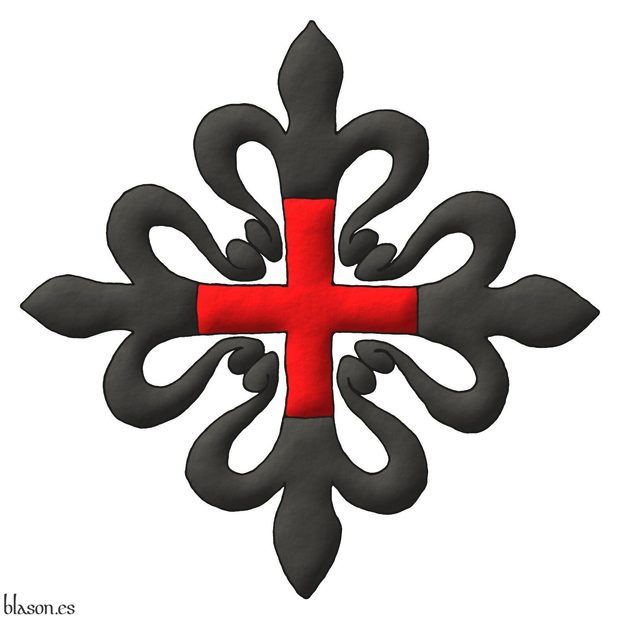
The Order of Saint Mary of Montesa and Saint George of Alfama, known as the Order of Montesa, was founded in the 14th century by the King of Aragon, James, as a military and religious order, to which he donated a castle in Valencia from which they took their name.
To endow the new Order of Montesa, the assets of the Order of the Templars, dissolved by Pope Clement V, were used. This is recounted by [Avilés, J.; 1780b; page 342] writing that Montesa was created «from the incomes and ruin of the Templars; as their Order was being extinguished, at the request of the Kings, so that said incomes would not leave the Kingdom.».
The order established within the Castle of Montesa, which previously belonged to the Templars, their convent and church of the Order, the palace of their Master, their barracks for fighting men, being able to form up to a couple of thousand of them in their parade ground. Their first Master, for 70 days since he died just over two months after his appointment, was Guillermo de Eril.
The origin and antiquity of the Military Order of Montesa, and the form of its Encomienda.
[Avilés, J.; 1780b; treatise IV, chapter VI, page 341] describes it as follows «The Military Order of Montesa was instituted in the year 1317 by the King of Aragon, Don Jaime II, and confirmed in the same year by Pope John XXII.».
Categories: Institution, Interpreted, Religious, Military, Illuminated, Outlined in sable, Freehand, Emblem, Cross of Montesa, Cross couped and Cross.


o-XI, heraldic document
Heraldic document, 2 pages.
The pages have a heraldic frame with the elements of his coat of arms.
The motto, which is the beginning of the Gospel of Saint John, can be seen in [Cnut Gospels; 1020; folio 111].
Blazon keywords: Quarterly, Sable, Or, One, Letter, Two, Wolf, Passant, In pale, Number, Gules, Argent, Azure, Crest and mantling, Helm, Mantling, Wreath, Crest, On, Charged, Disordered, Cross, Cross of Burgundy, Cross couped, Book, Open, Motto, Scroll and Fimbriated.
Classification: Created, Personal, Catalogue, Heraldic document and Frame.
Bearer: Salmerón Cabañas, Antonio.


Our Lady of Mercy, Order of
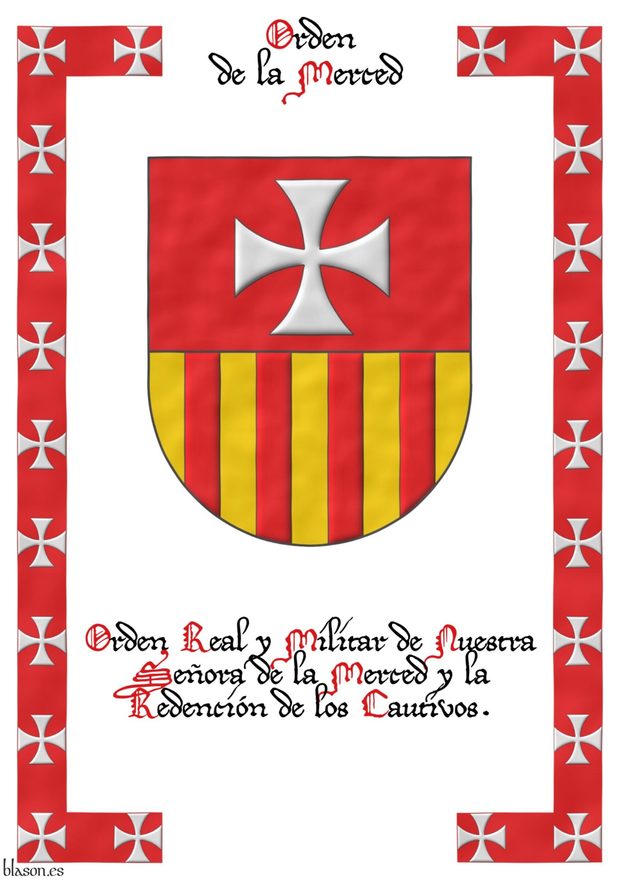
Royal and Military Order of Our Lady of Mercy and the Redemption of Captives.
Party per fess: 1 Gules, a cross patty Argent; 2 Or, four pallets Gules.
Escudo cortado: 1o de gules, una cruz patada de plata; 2o de oro, cuatro palos de gules.
Existing coat of arms which has been interpreted by me with the following characteristics: the mouth of the shield ends in a semicircular arch shape; the field has been enameled with flat tinctures of Gules color and Or metal; the cross patty and the pales are illuminated with Argent metal and Gules color; the whole has received a watercolor finish; and all within a Gules frame with 22 cross patties Argent, to which the name of its owner and blazon written in Sable and Gules tinctures is added.
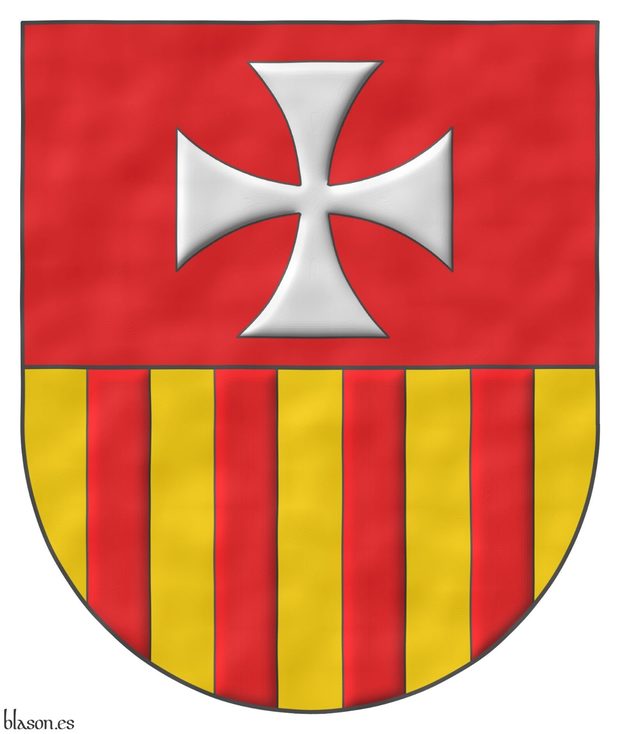
In [Medél, R.; 1846; plate 35, illustration 7] can be seen his interpretation of the coat of arms of the Order of Mercy.
The 2nd coat of arms of the Order of Mercy also illustrating this article is the same as the one included within the frame that appears in the 1st illustration of this article.
Another way to write the blazon of the coat of arms of the Order of Mercy could be the following, which simplifies the description of the 2nd quarter by saying that they are the arms of Aragon:
Party per fess: 1 Gules, a cross patty Argent; and 2 Or, four pallets Gules.
This coat of arms has been classified within the category called religious heraldry.
Blazon keywords: Party per fess, Gules, Or, Argent, Cross, One, Cross patty, Cross couped and Pale.
Style keywords: Semi-circular, Illuminated, Outlined in sable and Watercolor.
Classification: Interpreted, Religious and Frame.
Bearer: Our Lady of Mercy, Order of.


Province of Cáceres, structured blazons in parallel
Blazon keywords: Argent, Purpure, Gules, Or, Azure, Party per pale, Castle, Lion, Port and windows, Masoned, Rampant, Armed, Langued, Crowned, Crest and mantling, Crown, Open royal crown, Behind the shield, Cross, Cross of Alcantara and Cross couped.
Style keywords: Semi-circular, Illuminated and Watercolor.
Classification: Interpreted, Civic, Coat of arms and Structured and parallel blazons.
Bearer: Cáceres, Province of.


Rivas of Aragon, lineage
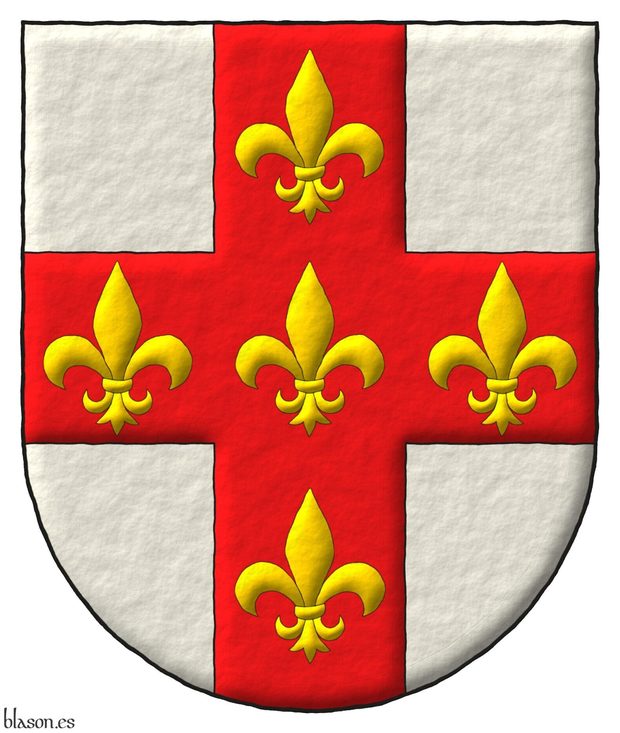
Argent, on a cross Gules five fleurs de lis Or.
Escudo de oro, una cruz de gules cargada de cinco flores de lis de oro.
Arms depicted by me, illuminated with lights and shadows, contoured in Sable, with a semi-circular outer contour and with a freehand finish.
Ancient arms of the lineage Rivas of Aragon emblazoned by me. Alternative blazon: «Argent, a cross Gules charged with five fleurs de lis Or».
Blazon keywords: Argent, Gules, Or, One, Five, Cross, Charged and Fleur de lis.
Style keywords: Outlined in sable, Illuminated, Semi-circular and Freehand.
Classification: Personal, Lineage, Interpreted, Boa and Coat of arms.
Bearer: Rivas of Aragon, lineage.


Robert George Alexander Balchin
Quarterly: 1 and 4 Vert, a crescent within eight mullets in lozenge Or; 2 and 3 Azure, a chain fesswise throughout between three fleurs de lis, 2 and 1, all the links and fleurs de lis per pale Or and Argent; an inescutcheon Azure, bearing a crown of count, charged with an eagle displayed within a bordure Or. Crest: A crown of Baron. Behind the shield the cross of a Knight of Justice of the Most Venerable Order of the Hospital of Saint John of Jerusalem.
Coat of arms emblazoned by me with a pointed shape, illuminated, and with a watercolor finishing.
G0067, Chief Herald of Malta's grant of Robert George Alexander Balchin's arms, whose full achievement has been emblazoned by me for such grant.
Blazon keywords: Quarterly, Vert, One, Crescent, Eight, Mullet, In lozenge, Or, Azure, Chain, Fesswise, Throughout, Between, Three, Fleur de lis, Ordered, Party per pale, Argent, Inescutcheon, Crest and mantling, Crown of Count, Crown, Charged, Eagle, Bordure, Crown of Baron, Behind the shield and Cross.
Style keywords: Outlined in sable, Illuminated, Watercolor and Pointed.
Classification: Personal, Interpreted, Coat of arms and Doctor.
Bearer: Balchin, Robert George Alexander.


![Ver [Royal Council of the Orders of Chivalry] en instituciones citadas. Fortaleza de oro y mazonada de sable.](../css/Fortaleza.Institucion.png)
Royal Council of the Orders of Chivalry
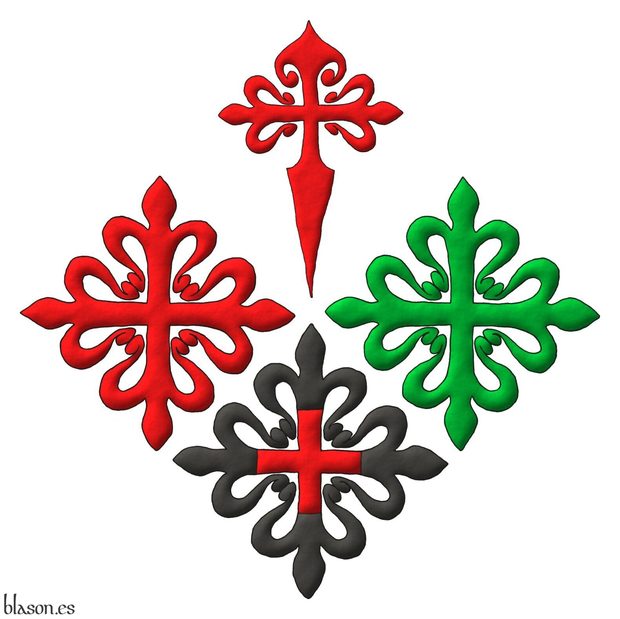
In 1523, the Order of Santiago, the Order of Calatrava, and the Order of Alcantara were definitively incorporated into the Crown of Castile, which marked the consolidation of the Royal Council of the Orders of Chivalry of Santiago, Calatrava, Alcantara, and Montesa. However, it is known that this Royal Council already existed at the beginning of the same 16th century, or even earlier, although there are no foundational documents available to date its inception.
The internet address of its website is ordenesmilitares.es where it also hosts the pages dedicated to each of its four orders:
- Order of Chivalry of Santiago: ordenesmilitares.es/orden-de-santiago.
- Order of Chivalry of Calatrava: ordenesmilitares.es/orden-de-calatrava.
- Order of Chivalry of Alcantara: ordenesmilitares.es/orden-de-alcantara.
- Order of Saint Mary of Montesa and Saint George of Alfama: ordenesmilitares.es/orden-de-montesa.
After the Crusades ended and following the model of the military orders created in the Holy Land, European kings established Orders of Chivalry, many of which were military and religious institutions, like the four grouped under this Royal Council.
Categories: Institution, Interpreted, Socioeconomic, Illuminated, Outlined in sable, Freehand, Emblem, Cross, Quarterly per saltire, Cross of Saint James, Cross couped, Cross of Calatrava, Cross of Alcantara and Cross of Montesa.


Sainte Croix de la Sabliere, Jean-Yves de

Azure, a cross ermine fimbriated Or, between four fleurs de lis Argent, each enfiled in a crown Or.
Escudo de azur, una cruz de armiños, perfilada de oro, acompañada de cuatro flores de lis de plata, cada una enfilada de una corona de oro.
Coat of arms emblazoned by me, highlighted with lights and shadows, contoured in Sable, with a pointed external shape and with a freehand finish.
G0128, Chief Herald of Arms of Malta's grant of the coat of arms of Jean-Yves, de Sainte Croix de la Sabliere, UK. This coat of arms has been emblazoned by me.
Blazon keywords: Azure, Or, One, Four, Cross, Ermine, Fimbriated, Between, Fleur de lis, Enfiled and Crown.
Style keywords: Outlined in sable, Illuminated, Pointed and Freehand.
Classification: Personal, Interpreted, Boa and Coat of arms.
Bearer: Sainte Croix de la Sabliere, Jean-Yves de.


Sánchez de Perella, Alfonso

Azure, a cross flory voided Argent; a bordure Gules charged with sixteen saltires couped Or.
Escudo de azur, una cruz hueca flordelisada de plata; una bordura de gules cargada de dieciséis sotueres cortados de oro.
Coat of arms interpreted by me, highlighted with lights and shadows, contoured in Sable, with a semi-circular outer contour and with a leather finishing.
Coat of arms of Alfonso Sánchez de Perella, 1st Mayor of Burgos, emblazoned by me.
Blazon keywords: Azure, Argent, Gules, Or, One, Sixteen, Cross, Flory, Voided, Bordure, Saltire and Couped.
Style keywords: Outlined in sable, Illuminated, Semi-circular and Leather.
Classification: Personal, Interpreted, Boa and Coat of arms.
Bearer: Sánchez de Perella, Alfonso.


![Ver [Santiago, Order of] en instituciones citadas. Fortaleza de oro y mazonada de sable.](../css/Fortaleza.Institucion.png)
Santiago, Order of
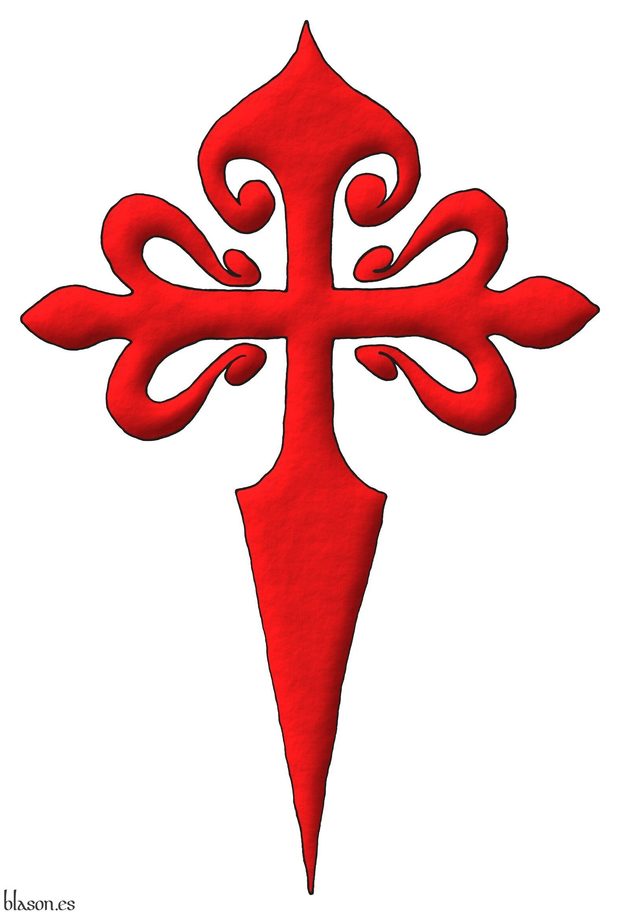
The Order of Chivalry of Santiago is both military and religious. It was founded in the Kingdom of León during the 12th century, although there is a difference of opinion regarding its exact year of foundation. It is named after the patron saint of Spain, James the Greater.
The purpose of its foundation was the protection of the Way of Saint James and the pilgrims who traveled it, and to participate militarily in the advancement of the reconquest of the Iberian Peninsula.
Of the Military Order of Santiago of the Sword, of its origin, and antiquity, as well as the form of its Commandery
[Avilés, J.; 1780b; treatise IV, chapter II, page 325] writes «The oldest authentic instrument that is found regarding the origin of the Order of Chivalry of Santiago of the Sword», observe how José de Avilés e Iturbide refers to the order in the masculine form, «is the donation made in the years of 848», note how the Marquess of Avilés does not doubt the antiquity of this order and even in other subsequent paragraphs, he dates it even earlier than currently believed, «made to the Church of Santiago by the King of León Don Ramiro in memory of the famous victory he achieved against the Moors in the battle of Clavijo (two leagues from Logroño), as evidenced by its Privilege, for having seen this Holy Apostle armed and mounted on a Horse, fighting in defense of the Christians; to whose devotion, and in this recognition, the said Order was instituted, taking from it its origin and name, as well as the same Cross that the Saint bore on his chest, and Shield, represented in the form of a Sword, of red color», gules ~ red, «for the blood shed of the Infidels, of whom Don Rodrigo Ximenez, Archbishop of Toledo, in his Chronicle Book VII says»: «Kubet ensis sanguine Arabum».
Drawing with a single stroke
Cross of Saint James the Greater drawing by me with a single stroke. This is the reason why it is asymmetrical, it has the base tip crooked, there are some sides higher than others, and it shows the failure of my pulse in a certains turns.
It is by far my most downloaded and copied painting, the most used on websites, citing me or not, the most used in hotels advertising, parish sheets... and even on T-shirts.
Categories: Institution, Interpreted, Religious, Military, Illuminated, Outlined in sable, Freehand, Emblem, Cross of Saint James, Cross couped and Cross.


Savoy, Duchy of
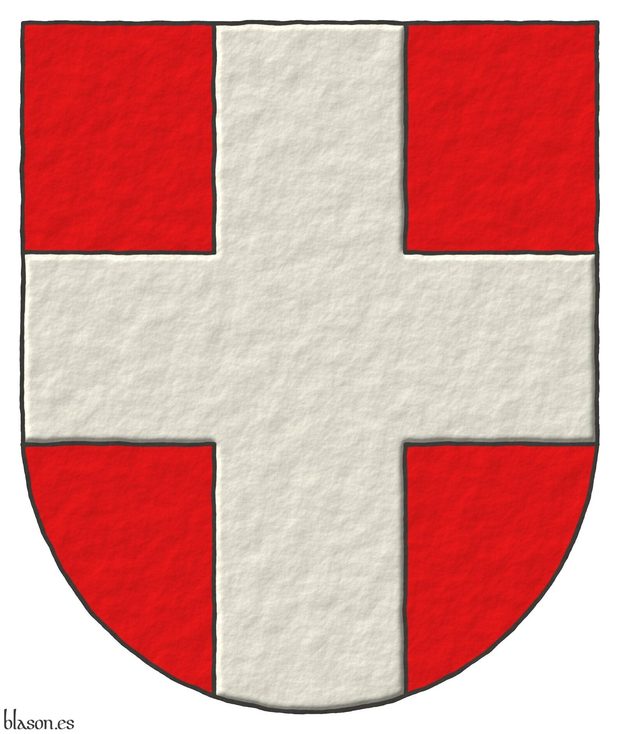
Gules, a cross Argent.
Escudo de gules, una cruz de plata.
Coat of arms of the House of Savoy and the Duchy of Savoy, which I have interpreted as follows: the shield has a semicircular (round) base; the field is illuminated in flat tincture Gules; the cross is illuminated in Argent; and the whole coat of arms is rendered with a raised-stroke effect.
This coat of arms is both familial and political, for it is also the coat of arms of the French departments of Savoy and Haute-Savoie, both belonging to the Rhône-Alpes region.
The cross in this shield is an honourable ordinary, for it is a full cross, the result of combining a fess and a pale. This full cross is wide and reaches the edges of the shield and is therefore large enough to bear charges. For this reason these ordinaries are called “honourable,” because they may be honoured with additional charges. In English heraldry they are known as «ordinaries», [The Heraldry Society; 2013; page 11].
This coat of arms is recorded in the armorial [Marshal, L.; 1295; shield number 32] together with the text «Le Counte de Sauveys, Gules a cross argent, Amadeus V, Comte de Savoie».
Blazon keywords: Without divisions, Gules, Argent and Cross.
Style keywords: Semi-circular, Illuminated and Freehand.
Classification: Interpreted, Personal, Coat of arms and House of Savoy.
Bearer: Savoy, Duchy of.


Scheme with a pale and a cross
Proportions of the cross and its similarity with the pale.
This schema shows two coats of arms, the first with the proportion scheme of a pale, the second with the proportion scheme of a cross, and allows us to observe the common proportions between a pale and a cross.
Blazon keywords: Without divisions, Pale and Cross.
Style keywords: Semi-circular.
Classification: Schema and Coat of arms.
Bearer: Saboya, Ducado de.


Standard of Nick Allen Rica II
Structure of this standard:
- His coat of arms.
- His badge.
- The 1st line of his motto.
- His crest.
- The 2nd line of his motto.
- His badge.
Blazon keywords: Or, One, Chevron, Gules, Charged, Three, Crescent, Argent, Between, Cross, Flory, Pomegranate, Proper, Slipped, Leaved, Vert, Motto and Four crescents joined millsailwise.
Style keywords: Outlined in sable.
Classification: Personal, Created, Standard and Flag.
Bearer: Rica II, Nick Allen.


Standard of Tim Wilkins
Structure of this standard:
- Argent, a cross gules.
- The 1st line of his motto.
- His coat of arms.
- The 2nd line of his motto.
- His badge.
Blazon keywords: Cross, Gules, Motto, Party per bend sinister, Or, Surmounted, Gauntlet, Sable, Palewise, Peacock, In his splendour and Proper.
Classification: Personal, Interpreted, Standard and Flag.
Bearer: Wilkins, Tim.


Stuart, John

Or, a fess chequey Argent, charged with an ermine spot, and Azure, between in chief two cross patty Gules, in base a thistle proper; a diminished bordure Azure.
Escudo de oro, una faja ajedrezada de plata, cargada de una cola de armiño, y azur, acompañada en jefe de dos cruces patadas de gules, en base de un cardo al natural; una filiera de azur.
Coat of arms painted by me, highlighted with lights and shadows, outlined in Sable, with a semi-circular outer contour and with a watercolor finish.
Coat of arms of Reverend John Stuart, XVIII century, emblazoned by me.
Blazon keywords: Or, Argent, Azure, One, Three, Nine, Two, Fess, Chequey, Charged, Ermine spot, Between, In chief, Cross, Patty, In base, Thistle, Proper and Diminished bordure.
Style keywords: Outlined in sable, Illuminated, Semi-circular and Watercolor.
Classification: Personal, Interpreted, Boa and Coat of arms.
Bearer: Stuart, John.


The coat of arms of Gilbert Hérail in 3 steps
Argent, a cross Azure.
Blazon keywords: Argent, One, Cross and Azure.
Style keywords: Outlined in sable, Illuminated, Semi-circular, Plain tincture and Freehand.
Classification: Religious, Military, Knights Templar, Interpreted, Coat of arms and Schema.
Bearer: Hérail, Gilbert.


Trading Pro School
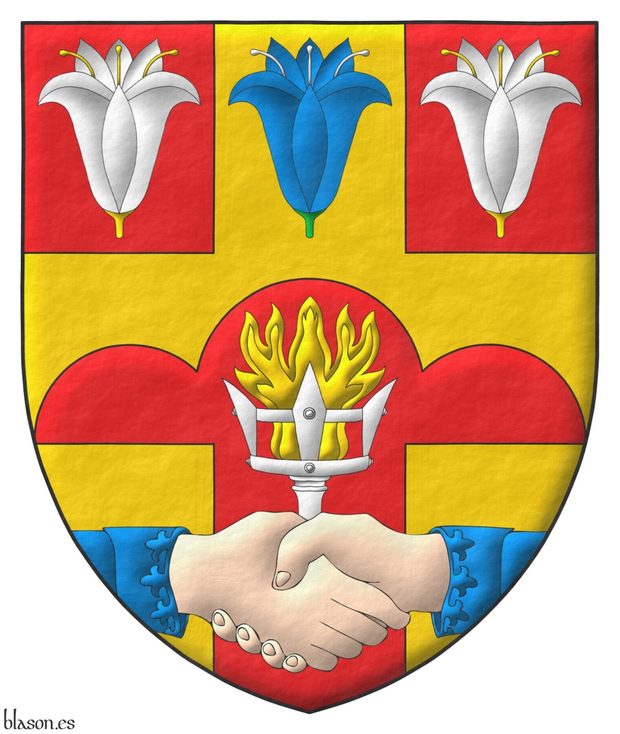
Illuminated and a rough finishing.
Blazon keywords: Gules, Cross, Or, Lily, Slipped, Seeded, Argent, Azure, Vert, In chief, Charged, Trimount, Counterchanged, Torch, In base and Two hands clasped.
Style keywords: Rough, Outlined in sable, Illuminated and Pointed.
Classification: Socioeconomic, Created and Coat of arms.
Bearer: Trading Pro School.


UBU
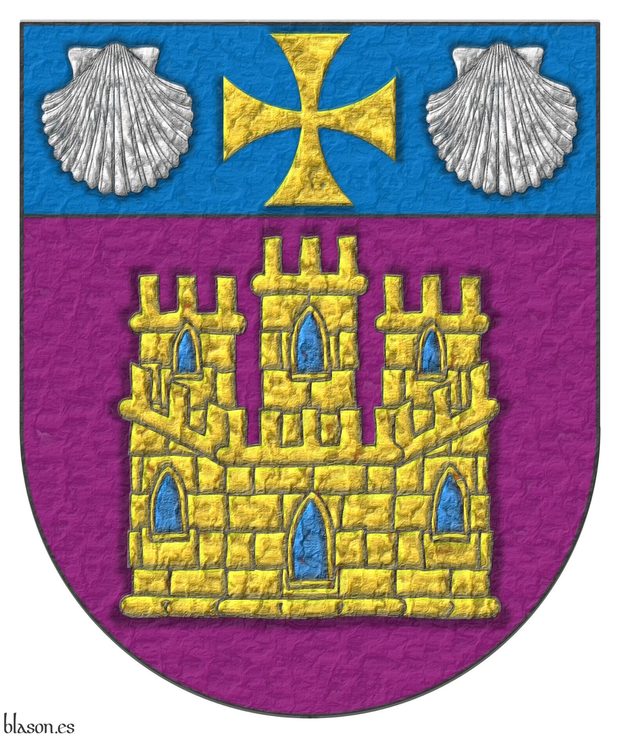
Purpure, a castle triple-towered Or, port and windows Azure, masoned Sable; on a chief Azure, a cross patty Or, between two escallops Argent.
Escudo de púrpura, un castillo de oro, aclarado de azur, mazonado de sable; un jefe de azur, cargado de una cruz patada de oro acompañada de dos veneras de plata.
Coat of arms interpreted as follows: with a semicircular (round) base; the field and the chief in the flat tinctures Purpure and Azure, with a lightly-hammered metal finish; and the four charges outlined in Sable, shaded, illuminated, and with a very hammered metal finish.
I hold the University Specialist degree in Real Estate Management and Administration, awarded by the Department of Private Law of the University of Burgos. These studies are structured over three academic years and are pursued online in combination with periods of traditional classes in the summers and on-site examinations during the winters. This was my first long-term online training experience.
Blazon keywords: Purpure, Or, Azure, Sable, Argent, Castle, Chief, Cross, Cross patty, Cross couped and Escallop.
Style keywords: Semi-circular, Illuminated, Shaded, Outlined in sable, Soft metal and Hard metal.
Classification: Interpreted, Socioeconomic and Education.
Bearer: Burgos, University of.


Vidriales, C. M.
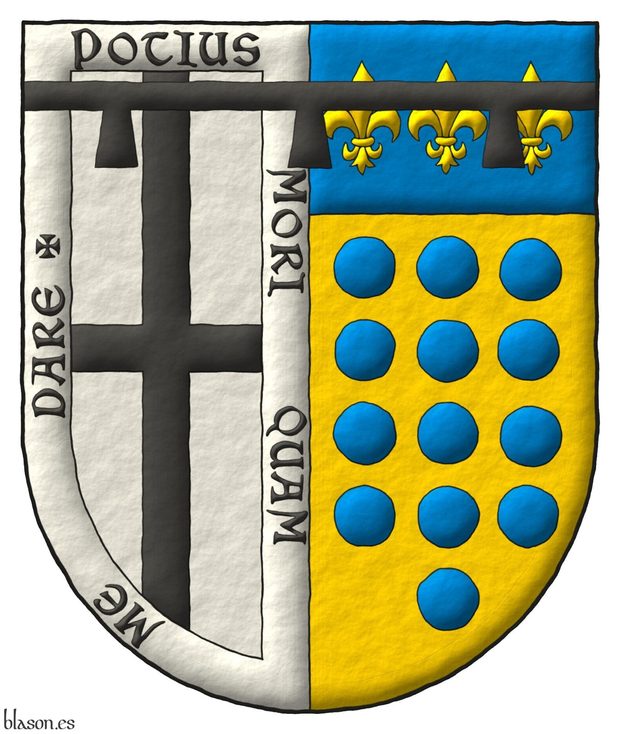
Interpreted coat of arms: with a semi-circular shape; illuminated with metals argent and or and colors sable and azure; outlined with sable; and a freehand finish.
Blazon keywords: Party per pale, Argent, Cross, Sable, Bordure, Motto, Or, Thirteen, Hurt, Hurt, torteau, pellet, pomme and golpe, Azure, Three, In pale, Four, Five, Chief, Fleur de lis, Label and Suspended.
Style keywords: Freehand, Semi-circular, Illuminated and Outlined in sable.
Classification: Coat of arms, Interpreted and Personal.
Bearer: Vidriales, C. M..


Vidriales, M. P.
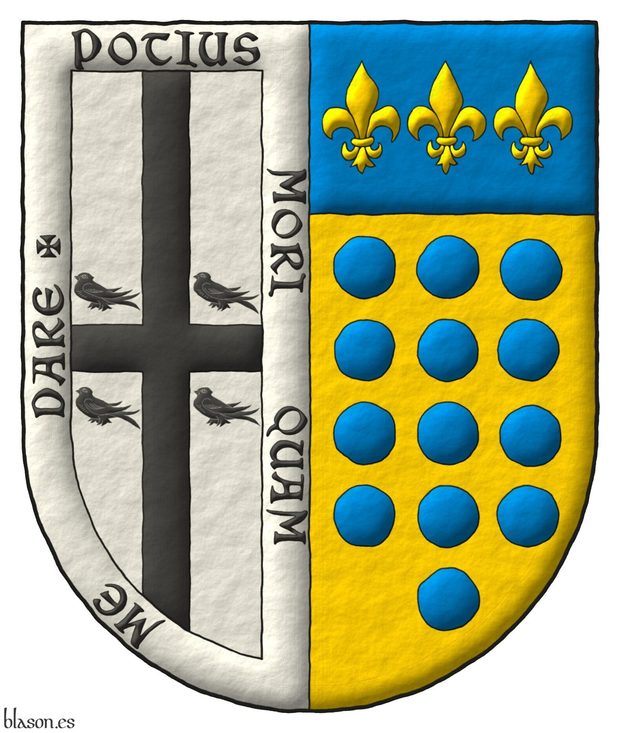
Interpreted coat of arms: with a semi-circular shape; illuminated with metals argent and or and colors sable and azure; outlined with sable; and a freehand finish.
Blazon keywords: Party per pale, Argent, Cross, Sable, Bordure, Motto, Or, Thirteen, Hurt, Hurt, torteau, pellet, pomme and golpe, Azure, Three, In pale, Four, Five, Chief, Fleur de lis, Cantoned and Martlet.
Style keywords: Freehand, Semi-circular, Illuminated and Outlined in sable.
Classification: Coat of arms, Interpreted and Personal.
Bearer: Vidriales, M. P..


YouTube
Heraldry videos
- Heraldic panther on the arms of the residential neighborhood of Centro, Val'Quirico, Tlaxcala, Mexico.
- Pennon of the residential village of Abundanttia, Val’Quirico, Tlaxcala, Mexico.
- Jean-Christophe Loubet del Bayle's arms.
- Arms of Juan Lanzagorta Vallin.
- How I emblazon the coat of arms of Richard Arthur Brinnhard.
- Coat of arms of Lucas Cruz's family.
- Pennon of Centro, Val’Quirico, Tlaxcala.
- Arms of Jean-Christophe Loubet del Bayle emblazoned by me step by step.
- Standard of Rudolf Juchter van Bergen Quast.
- Coat of arms of Lucas Cruz family designed by him and me and emblazoned by me.
- Coat of arms of Seth Rawson emblazoned by me v.2.
- Coat of Arms of Seth Rawson.
- v.2 Party per chevron: How to blazon and emblazon it, example, Laird Sky's arms.
- v.1 Party per chevron: How to blazon and emblazon it, example, Laird Sky's arms.
- Coat of Arms of Mr. Paul Bengamin Lindsay.
Heraldic channel
My heraldic channel at YouTube is youtube.com/user/ASalmeronTube.
Categories: Technology, Social networks, Cross, Argent, Pomegranate, Bridge, Tower, Escutcheon, Tree, Fish, Bordure, Compony, Eagle, Lion, Pale, Castle, Bell tower, Plough share, Ship, Semé and Fleur de lis.
-
Language
-
Categories of heraldry
-
Divisions of the field
- Without divisions
- Party per pale
- Party per fess
- Party per bend
- Party per bend sinister
- Tierce
- Tierce sinister
- Tierced per pale
- Tierced per fess
- Tierced per bend
- Tierced pallwise inverted
- Quarterly
- Quarterly per saltire
- Gyronny
- Party per fess, the chief per pale
- Party per pale, the sinister per fess
- Party per fess, the base per pale
- Party per pale, the dexter per fess
- Chapé
- Chaussé
- Embrassé
- Contre-embrassé
- Party per chevron
- Enté
- Enté en point
- Flanched
-
Metals
-
Colours
-
Furs
-
Other tinctures
-
Ordinaries and sub-ordinaries
-
Diminutives of the ordinaries
-
Geometric charges
-
Composite ordinaries
-
Inanimate charges from Nature
Atom, Crescent, Diamond, Emerald, Estoile, Increscent, Lightning flash, Moon, Mount, Mullet, Mullet of four points, Orbital, Plough of Ursa Major, Rainbow, Ray of the sun, River, Sea, Snowflake, Sun, Sun in splendour, Sun of May, Trimount, Water and Wave.
-
Vegetal charges from Nature
Acorn, Apple, Apple tree, Ash, Bluebonnet, Camellia, Chrysanthemum, Cinquefoil, Cornflower, Dogwood flower, Double rose, Elm, Fleur de lis, Flower, Gourd, Holm oak, Hop cone, Kapok tree, Laurel, Lily, Linden, Lotus flower, Madonna lily, Mexican cedar tree, Oak, Olive tree, Palm tree, Plantain plant, Pomegranate, Poplar leaf, Rose, Shamrock, Sunflower, Thistle, Tree, Tulip, Vine and Wheat.
-
Animal charges from Nature
Badger, Bald eagle, Barbel, Barn owl, Bear, Beaver, Beetle, Bighorn sheep, Blackbird, Boar, Brach hound, Bull, Doe, Dog, Dolphin, Dove, Eagle, Elephant, Falcon, Female figure, Fish, Flame, Fly, Fox, Frog, Goat, Goldfinch, Goose, Heron, Horse, Hummingbird, Jaguar, Lark, Leopard, Lion, Lion passant, Lion rampant guardant, Lioness, Lynx, Male figure, Martlet, Merino ram, Owl, Panther, Parrot, Peacock, Pelican, Pelican in her piety, Puffin, Quetzal, Raven, Roe deer, Rooster, Savage, Seagull, Serpent, She-wolf, Stag, Starling, Talbot, Tyger, Vulture, Warren hound and Wolf.
-
Parts of natural charges
Arm, Beak, Branch, Caboshed, Chest, Claw, Covert, Dorsal fin, Eagle claw, Ermine spot, Escallop, Feather, Foot (palmiped), Foreleg, Forepaw, Hand, Head, Heart, Hoof, Leaf, Neck, Ostrich feather, Palm frond, Paw, Roe deers' attires, Shoulder, Sprig, Stags' attires, Stem, Swallow-tail, Tail, Tail addorsed, Tail fin, Talon, Tooth, Trunk, Trunk (elephant), Two hands clasped, Two wings in vol, Udder, Wheat spike, Wing and Wrist.
-
Artificial charges
Ace of spades, Anchor, Anvil, Arch, Arm vambraced, Armillary sphere, Arrow, Axe, Bell, Bell tower, Beret, Bonfire, Book, Bookmark, Bow, Branding iron, Bridge, Broken, Buckle, Cannon, Cannon dismounted, Cannon port, Canopy roof, Carbuncle, Castle, Celtic Trinity knot, Chain, Chess rooks, Church, Clarion, Clay pot, Closed book, Club, Column, Comb, Compass rose, Conductor's baton, Cord, Covered cup, Crozier, Crucible, Cuffed, Cup, Cyclamor, Dagger, Double vajra, Drum, Ecclesiastical cap, Fanon, Federschwert, Fleam, Four crescents joined millsailwise, Galician granary, Garb, Gauntlet, Geometric solid, Grenade, Halberd, Hammer, Harp, Host, Hourglass, Key, Key ward, Knight, Knot, Lantern, Letter, Line, Loincloth, Menorah, Millrind, Millstone, Millwheel, Monstrance, Mortar, Mullet of six points pierced, Nail, Non-classic artifact, Norman ship, Number, Oar, Oil lamp, Open book, Page, Pair of scales, Parchment, Pestle, Piano, Pilgrim's staff, Plough share, Polish winged hussar, Port, Portcullis, Potent, Quill, Ribbon, Rosette of acanthus leaves, Sabre, Sackbut, Sail, Scroll, Scythe, Sheaf of tobacco, Ship, Skirt, Spear, Spear's head, Stairway, Star of David, Step, Sword, Symbol, Tetrahedron, Torch, Tower, Trident, Trumpet, Turret, Two-handed sword, Wagon-wheel, Water-bouget, Wheel, Winnowing fan and With a turret.
-
Immaterial charges
Angel, Archangel, Basilisk, Dragon, Dragon's head, Garuda, Golden fleece, Griffin, Heart enflamed, Justice, Mermaid, Our Lady of Mercy, Ouroboros, Paschal lamb, Pegasus, Phoenix, Sacred Heart of Jesus, Saint George, Sea-griffin, Trinity, Triton, Unicorn, Winged hand and Wyvern.
-
External elements
-
Heraldic creations
-
References
-
Formats
-
Keywords on this page
Between, Watercolor, Proper, Pointed, Azure, Flag, Bend sinister, Boa, Bordure, Wreath, Charged, Crest, Five, Crown, Created, Cross, Cross couped, Four, Outlined in sable, Two, Emblem, Coat of arms, Fess, Fleur de lis, Personal, Gules, Illuminated, Institution, Interpreted, Chief, Mantling, Motto, Lion, Semi-circular, Military, Or, Pale, Party per pale, Argent, Without divisions, Religious, Hurt, torteau, pellet, pomme and golpe, Sable, Vert, Saltire, Freehand, Three, One and Helm.

